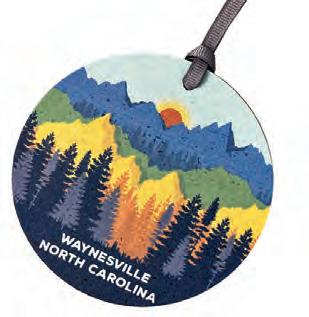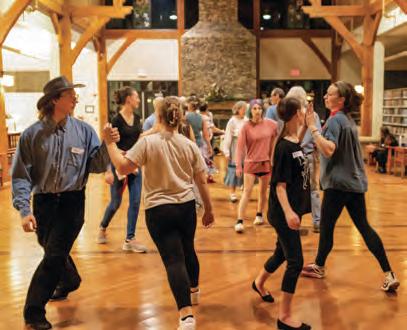Page 10
Smokies remain open amid shutdown — for now Page 24



Page 10
Smokies remain open amid shutdown — for now Page 24


At midnight on Oct. 1, a continuing resolution allowing the federal government to continue operating lapsed, and the country was thrown into a shutdown. This affects folks in Western North Carolina in a number of ways, from basic services to Section 8 housing to management of federal lands. The Smoky Mountain News dives in to provide some details. shutterstock.com image
Newcomer, incumbents vie for Bryson City Board of Aldermen..........................4
Shutdown halts federal government, WNC braces again......................................6
Shutdown spares most of WNC disrupts some services......................................9
Local housing initiatives impacted by shutdown ..................................................10 Franklin municipal candidates weigh in on local issues........................................12
Dictators love to blame “The Boogeyman”................................................................14 DEI’s intent is honorable..................................................................................................14
Roving
Smokies open amid shutdown — for
Up Moses Creek: A bumper
micah@smokymountainnews.com D
jessica.m@smokymountainnews.com Jack Snyder.
D IGITAL MARKETING S PECIALIST Tyler Auffhammer. . . .
ADVERTISING SALES: Amanda Bradley. .
Maddie Woodard. .
C LASSIFIEDS: Jamie Cogdillr. . . . . . .
N EWS E DITOR: Kyle Perrotti. .
WRITING: Lily Levin. .
Cory Vaillancourt.
Garret K. Woodward. .
ACCOUNTING & O FFICE MANAGER: Jamie Cogdill. . .
jack.s@smokymountainnews.com
tyler.a@mtnsouthmedia.com
amanda.b@smokymountainnews.com
maddie.w@smokymountainnews.com
classads@smokymountainnews.com
kyle.p@smokymountainnews.com
lily.l@smokymountainnews.com
cory@smokymountainnews.com
garret@smokymountainnews.com
smnbooks@smokymountainnews.com
C ONTRIBUTING: Jeff Minick (writing), Susanna Shetley (writing), Adam Bigelow (writing), Thomas Crowe (writing)
WAYNESVILLE | 144 Montgomery, Waynesville, NC 28786
SYLVA | 629 West Main Street, Sylva, NC 28779
P: 828.452.4251 | F: 828.452.3585
I NFO & B ILLING | P.O. Box 629, Waynesville, NC 28786



Copyright 2025 by The Smoky Mountain News.™ Advertising copyright 2025 by The Smoky Mountain News.™ All rights reserved. Reproduction in whole or in part without permission is prohibited. The Smoky Mountain News is available for free in Haywood, Jackson, Macon, Swain and parts of Buncombe counties. Limit one copy per person. Additional copies may be purchased for $1, payable at the Smoky Mountain News office in advance. No person may, without prior written permission of The Smoky Mountain News, take more than one copy of each issue.
SUBSCRIPTION: 1 YEAR $80 | 6 MONTHS $55 | 3 MONTHS $35































































“Well, we don’t really know where to begin beca 10! THE
e to anyone who is looking for a new home, investment property, or selling. communication. Very approachable and open to discuss any uncertain feelings you ma e for at time. Catherine is a true gem of Haywood county and continues rrounding areas. She is prompt and pro active, with a heart of gold, she looks out fo ause Catherine treats you like family. She looks out for your best interest at he
current on business. You won’t be disappointe new investment. I would recommend Catherine the current market and is very open with her c she is buying a home for her own family for the estate and knows Haywood county and the sur
-Austin Chambers


would fall under the homeless category in this county choose that lifestyle,” he said. Of the remaining percentage, “probably half of those are mentally ill,” and the other half “are stuck there and would really, really like to get out.”
Maxey told SMN that he’d be in favor of working with nonprofits to expand emergency housing efforts, which should prioritize the final group he listed, rather than “the people pooping and peeing and breaking in and stealing.”
According to the United States Interagency on Homelessness, which also dispels the myth that “people experiencing homelessness choose to live outside in tents or cars,” 40-60% of people experiencing homelessness have a job.
As noted by a large-scale 2023 Pew Research Center study, the strongest determinant of homelessness — in addition to other influences like systemic discrimination, job loss, and limited access to social services like healthcare — is a scarcity of affordable housing.
As for affordable housing in Bryson City, the candidates agreed that the town had a shortage. All, however, said that Bryson City aldermen lack the power to do much about it.
BY LILY LEVIN
S TAFF W RITER
Three candidates — incumbents Tim Hines and Ben King, and newcomer W. Kent Maxey — are vying for two open seats on the Bryson City Board of Aldermen. Though aldermen serve four-year terms with odd-year staggered elections, Hines has only held the position since his appointment in April 2023 following Steve Augustine’s resignation. Nonetheless, Hines, who also works as a manager at Harrah’s Cherokee Casino, said he’s learned a lot about the nuanced nature of town issues throughout his time in office.
King, meanwhile, became a member in 2017.
In a conversation with The Smoky Mountain News, King, who co-owns an outdoor adventure business, said he might not have run again “if there would have been more interest out there from other candidates that were informed.”
Maxey, a videographer by trade, is a newcomer to political office but cited his “long history with town,” including his stepfather Bruce Medford’s near decade-long mayoral career.
All three candidates talked about a variety of issues. Homelessness, affordable housing, water and sewer rates and the Fontana Regional Library system were key among the topics discussed.
On what he called Bryson City’s “vagrancy issue,” Maxey felt strongly that it should be “addressed.”
“We need some vagrancy laws. I’m not sure what’s on the books now… I think if the police had that tool at their disposal, they would use it, because I know this is a pretty good drain on them,” he said.
Maxey suggested a law to ban “tents in the city limits on public property,” and another to limit time spent “in an area without either purchase or using of services.”
Hines, however, said there’s already a process in place for private citizens to address “concerns over some of the homeless population… being places they shouldn’t.” He praised the police department for its communication of procedures to town residents, like the ability to “post your property that no one [is allowed to] be here after dark or just during business hours.”
Hines said if business and property owners are still “having a problem with folks, then you can call it in” to Bryson City police.
According to the American Bar Association, however,



criminalizing homelessness “is the most expensive intervention to homelessness both in fiscal and human costs.”
King told SMN that he doesn’t “feel that he’s had significant issues with our unhoused residents that are out and about around town.”
“I know a lot of people are uncomfortable being put in situations where they have to confront another human being that may not be on the same socioeconomic status as they are,” he said, adding that the epidemic of houselessness spans nationwide, and “without multi-organization cooperation,” there’s no easy fix.
The homeless population throughout the United States increased 18% from 2023 to 2024.
“We as society don’t give a second chance a lot of the time, or maybe even a third chance,” King said.
One example he gave was a formerly incarcerated person trying to turn their life around.
Providing criminal history is typically mandatory on private sector job applications — and mandatory for all public sector applications at the county and city level, as neither Swain County nor Bryson City have enacted “ban the box” law reforms. Plus, when laws are passed that criminalize homelessness, a criminal record for those without housing becomes almost inevitable.
That means this individual wouldn’t find employment — and thus would be unable to finance a stable living situation, especially “somewhere like Bryson City, where housing is expensive,” King said.
Bryson City doesn’t have the funds to build and maintain a homeless shelter, but if it did, King would support the initiative.
Responding to that hypothetical scenario, Hines said would be “fantastic that a number of folks could get assistance” and a shelter “could be a step” toward solving homelessness, but it wouldn’t “reduce the homeless population” in town.
“I think our homeless numbers would go up, and I think [the shelter] would probably get flooded,” he said.
Hines’ work commute takes him through an area known to have a “lot of homeless population activity during the daytime,” he said, adding that he finds it sad how many new faces he sees. He said his “heart hurts for homeless people … there’s no judgement on my side of how you got into that situation.”
But that’s not how Maxey sees it.
“I believe that probably about 50-60% of the people who
Last summer, Bryson City residents saw their water bills increase, some by more than 300%. SMN reported on a charged Aug. 27, 2024 meeting following the rate hike. A few dozen townspeople expressed their outrage to Mayor Tom Sutton, who prematurely ended the meeting after tensions escalated.
As a result, for the alderman, water and sewer issues remain at the top of the list. King said he was excited to start the wastewater treatment facility, which government has been planning throughout “almost my entire time [in office].”
Sutton had spoken about the wastewater facility during the August 2024 meeting: expected costs were slated at $15 million to replace its old, underperforming pipes.
Hines echoed the need for a better functioning system.
“Many of those pipes are older than about every resident in the in the town,” he said.
Hines also emphasized the poor state of the town’s water lines.
“The current middle school is supplied by two water lines. One is down. So, we have one water line strapped to the bottom of Everett Street Bridge, and that supplies this entire side of the town,” he explained.
And if a natural disaster like Helene were to happen today and break the single remaining water line, he said, “this side of town would shut down.”
“I want to see through a lot of the projects that strengthen our infrastructure, because at the end of the day, [if] you don’t have an infrastructure, you don’t have a town,” Hines said.
Maxey discussed a longer history of water issues in the town.
“The water issue in Bryson City was in terrible shape when my stepfather, Bruce Medford, took over as mayor,” he said. “They found something like [200] to 300 city taps that were not even metered … We were facing fines … the pipes were caving in.”
He said a lot of work has been done to address the problem in the recent past — and that the work needs to continue.
“The issue is, the water rates just really didn’t go up to match it, and we’re not used to paying what water is worth.”
Maxey explained that Bryson City gets plentiful rainfall, so “we don’t think of water as being precious … like you do in a city.”
But it is precious, he said. It’s expensive to move and expensive to sanitize. For Maxey, the problem last year wasn’t rooted in the rate hike. It was about the lack of communication. Were he in office, he would’ve implemented a phased approach to payment increases and open lines of discussion throughout the process. F
Hines said he “will admit our communication process for when we initially raised rates … I understand a lot of folks may still be struggling with that.”
Nevertheless, he said it was an intentional decision made after consulting with outside partners like the UNC School of Government. All framed raising rates as the only way to finance solutions for the water system.
After the initial hike, rates went down “a hair,” he said, and “no one’s voiced a concern over water rates to me directly in almost a year.”
Whats more, according to Hines, the alternative would mean pulling from the general fund. To some, he explained, that feels like paying twice.
As for potential grant funding, an idea sometimes raised by constituents, Hines said Bryson City gets “a lot of grants and loans” — so many, in fact, that the town is nearly at its debt ceiling.
“There’s no such thing as free money everywhere. Someone paid for it at some point,” he said.
For King, it doesn’t help that “literally every other municipality across the state” is applying for the same grant funding. And after raising consumer rates, “last year was the first year water and sewer didn’t operate in the negative. We didn’t have to supplement [from the general fund],” he said. Like Hines, King thought public outrage diminished when rates lowered slightly, after the first jump.
“Everybody still may not like it,” he said, “but we the customers are the people that have to pay for the system.”
Candidates stood in unanimous agreement that censorship does not belong in libraries and that Jackson County’s vote to exit the Fontana Regional Library system due to concerns about LGBTQ+ content was a poor decision.
“I usually don’t make a ton of comments about things outside of my purview, but I will say… it’s a debacle,” said Hines of Jackson County pulling the plug.
He surmised that he “could probably go to any library on the planet, and there’s books in there that I don’t agree with.”
“If I was in that position [of navigating the situation], I don’t know if I’d beg Jackson County not to leave the system, but I would hope that they would have some more open discussions,” Hines added.
Hines recalled that he’d reached out to Jackson County officials to offer a “sounding board to talk some of this out.”
“Did anyone take me up on that? 0%,” he said.
Maxey discussed the Fontana Regional Library board, where a faction aligned with Jackson County decision makers has gained the ideological majority. He knows Cynthia Womble, who on Sept. 7 resigned as chair of that board but remains a voting member. She is not among those crusading against LGBTQ+ content.
“[Cynthia] is an amazing person. I cannot believe the crap that has gone on there.
Anything Cynthia says, I support,” Maxey said.
When asked about literature censorship, Maxey told SMN, “I think they’re making a big hoo-ha of nothing.”
King held a similar view.
“Everyone has the right in this country to be exposed to the information they choose to be exposed to,” he said. “Part of an educational process is to know what people think, feel, love, hate … I think that’s part of us being Americans.”
To King, the library is critical — and its role extends beyond the books. He envisioned a library with programming that might also function as a youth center, which is already underway via the Marianna Black Library expansion and renovation project.
To Hines, there’s another reason libraries are so important. Swain County is one of the poorest in the state, and internet and cell service aren’t always consistent.
“During the fall, I can see the cell tower, and it’s blinking, and I’ve got one bar of service,” he said.
If a student can’t purchase a cell phone or doesn’t have internet access, “they’ll just have to go to the library or park in the library parking lot and use Wi Fi there,” Hines added.
Maxey said his strength as a candidate was his love of the town — and the people in it.
“I’m going to spend time walking around town on the fourth of July and sticking out my hand. That’s just not [Mayor] Tom Sutton. It’s just not his personality. That’s my personality,” he said.
Hines said his communication skills are what makes him stand out.
“[From] my time in my professional career and some personal things that I do, I’m able to listen to people. People can get hot quick, and it doesn’t bother me. Usually, I’m pretty good at defusing a situation,” he said.
Hines wanted people to vote for him not because of his social connections, as is often the case in small towns, but because he is dependable and “explains his idea of what he votes on something hard.”
King spoke of his personal investment in Bryson City and desire to better it for everyone around him.
“I think there’s a good balance in the way we move forward with smart growth and smart decisions,” he said.
He also thought that it might be difficult to enter the board as a novice.
“We don’t get a lot of people that come to the meetings. I want to know that the folks running know all the things that we’ve been through in the past year. It just takes so long, if you’re uninformed, to get up to speed,” King said.
He emphasized the importance of getting involved in local politics — for everyone.
“The decisions made here every two weeks, or every month, affect your life way more significantly than the decisions made on a national level.”



Donations for the FRIENDS of the Haywood County Animal Shelter appreciated.





























BY CORY VAILLANCOURT POLITICS E DITOR
On Oct. 1, Republican-controlled Congress shut down the federal government, bringing a renewed round of confusion, finger-pointing and uncertainty to tourism-reliant Southern Appalachia — a region still paying the price for generational poverty, and still struggling with recovery from Hurricane Helene more than one year ago.
Shutdowns have been a feature of American politics for nearly half a century, but the tactic has become more common in recent decades and longer in duration. What began as a budgetary technicality has now become a policy weapon, wielded by both major parties at different times.
At the heart of every shutdown is the Antideficiency Act, originally passed in 1884 but subsequently amended many times. The law forbids the federal government from making expenditures or even accruing obligations without approved funding.
In practice, that means when appropriations bills aren’t enacted on time, federal agencies must wind down operations to avoid creating debt they cannot legally incur. Since the mid-1970s, that requirement has been interpreted strictly — without a budget, agencies begin shuttering offices, furloughing staff and halting nonessential services.
The distinction between “essential” and
“nonessential” employees has become one of the most visible features of a shutdown.
Federal workers who are considered essential — air traffic controllers, Transportation Security Administration officers, the military — are still required to report for duty, but their paychecks are delayed indefinitely. For many families, that creates an immediate strain as bills come due without any certainty of when income will arrive.
Meanwhile, nonessential staff, including park rangers, clerks and researchers, are sent home, forbidden from working until funding is restored.
Despite full Republican control of the federal government — the White House, the Senate, the House — some federal agencies have explicitly blamed “radical left Democrats” for the shutdown by posting statements on their websites. According to the Federal News Network, furloughed employees at the Department of Education found their automatic out-of-office email messages had been updated without their knowledge to blame Senate Democrats specifically.
According to government watchdogs, the false statements violate the Hatch Act, which prohibits using government resources to advance explicitly partisan messaging.
Democrats, though in the minority, do share at least some responsibility. They’ve dismissed several Republican plans without putting forward workable substitutes or showing the flexibility that might have accelerated a deal. Internal disagreements within
most visited — was abruptly closed. Barricades were erected at entrances, rangers were furloughed and local residents who relied on park roads for commuting were blocked.
“We love this area. We love coming to the park, and we spend a lot of money in this town,” Joe Parker, a Florida resident who visited the Deep Creek campground only to find it closed, told The Smoky Mountain News at the time. “It’s really too bad. We’re retired, so we’re pretty flexible with our plans, but I can imagine this shutdown has ruined many vacations.”
As the shutdown continued, the impact on tourism became clear. October is peak season in the Smokies and the sudden loss of access threatened hotels, restaurants and outfitters.
The Blue Ridge Parkway remained drivable, but restrooms were locked, trails were closed and services were unavailable. Visitors who did arrive found themselves restricted to roadside views — euphemistically called “windshield experiences.”
The effects of the 2013 shutdown, however, stretched far beyond public lands. Federal workers were sent home, veterans waited longer for benefits and community services tied to federal programs began to stall. The economic fallout touched local governments, families and small businesses alike.
Businesses connected to national parks and forests reported collapsing revenues. Gift shops emptied. Restaurants cut staff hours. Outfitters canceled trips.
the caucus have also weakened their response at key moments, undercutting their ability to bargain effectively — a perilous position, as the historical record suggests the longer a shutdown lasts, the more acute the pain becomes.
The first shutdown tied to a funding lapse took place in 1980, during the administration of President Jimmy Carter, when the Federal Trade Commission was shuttered for a single day.
Similar single-day stoppages occurred under President Ronald Reagan in 1981, 1984 and 1986, often the result of presidential vetoes.
In 1990, President George H.W. Bush’s reversal of his “read my lips, no new taxes” pledge provoked strong opposition in the House, and the government shut down for three days.
A few years later, President Bill Clinton and House Republicans led by Georgia congressman and Speaker Newt Gingrich clashed over spending priorities. The result was a five-day shutdown in November 1995, followed by a 22-day shutdown that stretched from mid-December into early January 1996. At the time, it was the longest shutdown in history.
The cycle continued into the 21st century. In 2013, Republican opposition to the Affordable Care Act led to a 16-day shutdown under President Barack Obama.
In October of that year, the Great Smoky Mountains National Park — the country’s
“I’ve had to cease all my tours,” Esther Blakely, owner of Cataloochee Valley Tours, said Oct. 8, 2013. “I don’t know what else to say.”
Families faced difficult choices as federal subsidies dried up. Childcare centers that relied on federal reimbursements teetered on the edge of closure, leaving parents scrambling.
Five years later, the cycle repeated itself. Early in 2018, during Donald Trump’s first term as president, a dispute over immigration and Deferred Action for Childhood Arrivals funding produced a three-day shutdown.
Near the end of that year, another shutdown began Dec. 22, 2018, and continued for 35 days — the longest in American history. By the time it ended, hundreds of thousands of federal workers had missed paychecks, and services from national parks to nutritional assistance programs had been disrupted. The ripple effects lingered well into 2019, leaving scars across WNC’s economy and testing the patience of residents.
During that shutdown, the federal government took a different approach to public lands than it did in 2013 — keep them open, but suspend upkeep and oversight.
“It’s sort of like having a restaurant and saying, ‘The restaurant needs to close for whatever reason, but we’re not going to close. We’re going to leave the restaurant open and we’re going to leave the food in here and turn the grill on and you all go at it,’” Carolyn Ward, current CEO of the Blue Ridge Parkway Foundation, said at the time. “It’s a little bit insane.”
By early January, conditions in F
the Smokies had deteriorated substantially. Trash cans overflowed, visitor centers were shuttered and safety hazards piled up with no rangers to respond.
Local residents stepped in where the government had withdrawn. Volunteers cleaned bathrooms, picked up trash and tried to help maintain the park. Philanthropic support also helped bridge the gap; a $65,000 donation allowed visitor centers to open during the Martin Luther King Jr. holiday weekend.
The Eastern Band of Cherokee Indians, heavily involved in the region’s outdoor economy, soon weighed in by petitioning then-congressman Mark Meadows (RAsheville) to help resolve the stalemate, warning of economic harm to Cherokee businesses tied to tourism.
Limited relief did come when the park tapped entrance fee revenues to restore some services. Restrooms reopened and some facilities returned, but staffing remained skeletal.
When the shutdown finally ended on Jan. 25, 2019, the damage was clear. Federal employees returned to work, but missed paychecks, canceled vacations and months of uncertainty left scars that stretched through the year.
through the Affordable Care Act marketplace. According to the Kaiser Family Foundation, in 2014 more than 357,000 people in North Carolina selected a marketplace plan. In 2025, it was more than 957,000.
Without congressional action, those subsidies will expire at the end of 2025, leaving many residents facing sharp premium increases as soon as new rates take effect this fall.
“We’ve been dreading it, because it’s just going to mean giving a lot of bad news to people,” said Jessi Stone, regional director of the health and economic opportunity program at Pisgah Legal Services.
Across the region, rural areas are still recovering from job loss and displacement attributable to Helene, making the situation all the more dire for some.
“We are dealing with so many other issues — people have spent their savings, people have lost jobs, lost their homes, so to try to reach in their pockets and find extra money for their health care cost is going to be really hard for people,” Stone said. “We anticipate a lot of people just aren’t going to be able to afford it.”
While it’s unclear exactly how much pre-
The last lapse in appropriations shut the federal government down from Dec. 22, 2018 through Jan. 25, 2019.
Source: North Carolina Department of Revenue, The Smoky Mountain News
Even with those setbacks, the Smokies proved resilient. Data from the North Carolina Department of Revenue show that despite the shutdown that lasted most of January, sales tax revenues still grew, year over year, in Haywood, Jackson and Macon Counties, but dipped slightly in Swain County. By the end of 2019, visitation numbers had climbed, masking the real hardship faced by families and small businesses that had endured weeks without support.
Whether that happens this time will become more apparent as the shutdown continues.
The current impasse stems from Republican leaders in Congress advancing a so-called “clean” funding measure that left out Democratic priorities for health and social programs.
One of those priorities, the failure to renew enhanced premium tax credits — temporary subsidies enacted by the Biden administration during the Coronavirus Pandemic — would have sweeping effects across the country and across the region.
The credits lower monthly health insurance costs for more than 24 million working adults and families who buy coverage
In much of the United States — and in WNC — the line between what remains operational and what doesn’t can be confusing.
The U.S. Postal Service keeps delivering mail, because it is funded through its own revenue. Social Security and Medicare continue paying benefits, because those programs operate under mandatory spending that isn’t tied to annual appropriations. Medicaid, food stamps and unemployment insurance also keep flowing in the short term. Federal courts remain open, although they may begin to scale back staffing if the lapse in funding continues.


IMMY CARTER (D)
May 1, 1980 — 1 day House: D Senate: D
ONALD R EAGAN (R) Nov. 23, 1981 — 1 day House: D Senate: D
Oct. 4, 1984 — 4 hours House: D Senate: R
miums will rise, experts anticipate major sticker shock, with some projecting rates could triple. That could lead to reduced enrollment, which would prompt insurers to raise premiums to make up for the loss in revenue, which in turn would result in an uptick in uninsured residents.
Health advocates warn the consequences could extend beyond household budgets; without affordable coverage, more people will delay care until emergencies arise, straining vulnerable rural hospitals and clinics.
“We’ve been doing navigator work since 2013. We know how important it is for people to have affordable, quality health care coverage and services. It just impacts everything in our community and economy,” said Stone, adding that marketplace plans also make it easier for people to start their own businesses without having to rely on a corporate employer for health care coverage.
Along with other nonprofits in the region, Pisgah Legal Services expects to see increased demand for help as open enrollment begins Nov. 1. Stone urged people with marketplace plans to review those plans and contact a navigator well before the enrollment period begins.
Other services quickly freeze. Passport offices stop processing applications. Inspections of food plants, environmental permits and workplace safety checks stall.
Contractors stop receiving payments for ongoing work. Research programs at universities and labs funded by federal grants grind to a halt. Federal agency websites may or may not be updated.
For much of the region, there’s an even bigger concern that could make the shutdown a double dose of disaster: counties like Haywood are still awaiting millions of dollars in reimbursements for recovery work related to Hurricane Helene.


Oct. 17, 1986 — 4 hours House: D Senate: R
G EORGE B USH (R) Oct. 8, 1990 — 3 days House: D Senate: D
ILL CLINTON (D)
Nov. 14, 1995 — 5 days House: R Senate: R
Dec. 16, 1995 — 21 days House: R Senate: R
BARACK OBAMA (D) Oct. 1, 2013 — 16 days House: R TRUMP (R) Jan. 20, 2018 — 3 days

Dec. 22, 2018 — 35 days House: D (R after Jan. 3, 2019)

In the midst of the mounting anxiety, a spokesperson for the Federal Emergency Management Agency told SMN on Oct. 1 its disaster operations would continue during the shutdown. Hazard mitigation programs, emergency management training and floodplain mapping all continue, at least for now. Most importantly, the distribution of reimbursements will not stop.
That leaves the most visible and concerning closures in WNC as the region’s public lands. On Oct. 1, Cades Cove Loop Road,
Oct. 1, 2025 — 8 days*
*Ongoing; data current as of Oct. 8 Wikipedia photos
Cades Cove Picnic Area, Cades Cove Visitor Center, Chimneys Picnic Area and Sugarlands Visitor Center all closed. October is normally a high point of the tourism calendar, drawing leaf-peepers from across the country to the Smokies. Hotels, restaurants and outfitters depend on those crowds to make ends’ meet. Around this time last year, many businesses in WNC were still mucking out their shops, trying to pick up the pieces from a devastating 1,000year storm. Those who survived have been
counting on a big fall season.
Instead, business owners fielded cancellations while bracing for a downturn just as their busiest season should be hitting stride.
One of the bigger drivers of visitation in the Smokies is the wedding industry.
“We’re all concerned about the shutdown,” said Ron Crivellone, who with his wife owns and operates Smokey Mountain Sounds, an event lighting and DJ service. “We’re trying to keep on top of it and also to ensure our information [about closures] is correct.”
Crivellone also serves as president of the Smoky Mountain Wedding Association, a nonprofit that promotes the industry across the region, and said he was already aware of at least one bride who had to scramble for an alternate venue when the venue she’d selected more than a year prior — Cades Cove — was closed. His wife Ellen said she had to help with a backup plan for another bride that had reserved Spence Cabin, near Elkmont. She fears more closures could be coming.
“Up until a few years ago, [the park] issued only a few hundred licenses and permits [for events like weddings] but now they issue many more,” Ron said. “There’s a lot going on in this industry. There are elopements and weddings every day in the park.”
Ron said the situation is especially worrying this year because the area has already faced challenges — the closure of Interstate 40 in the wake of Helene and a landslide on U.S. 441 that briefly severed an important artery through the park have slowed business for some.
“I don’t want to see any bride left without accommodations, but I’m more concerned in general for the area,” he said. “The fall season is what a lot of businesses like mine rely on to get through the winter months.”
That’s a fact not lost on Corrina Ruffieux,
executive director of the Haywood County Tourism Development Authority.
Ruffieux said that after Helene last fall, local tourism suffered losses on a scale “of which we’ve never seen and hopefully will never see again.” Occupancy tax collections for October 2024 were down on the order of 40% compared to the year before, and the effects rippled through restaurants, shops and attractions that depend on visitors for survival.
“We do not need another repeat of last October,” she said. “If people aren’t travel-
impact on tourism. In Haywood in particular, our top three attractions are public lands, federally operated, and if they close, that’s really going to impact our small businesses that rely on those visitors for spending.”
At a broader level, Ruffieux urged federal lawmakers to put aside partisan conflict.
“Everybody in the travel and tourism industry — U.S. Travel Association, Destinations International and state offices of tourism, down to local offices — we just encourage our congressional representatives to find a way to come to a compromise and get back open,” she said.
“We’ve been dreading it, because it’s just going to mean giving a lot of bad news to people.”
— Jessi Stone,
ing, they’re also not visiting our local attractions, shops, restaurants — and sales tax numbers, of course, reflect those decreases as well.”
For now, she said, many destinations in the region remain unaffected.
“Cataloochee Valley is open. Oconaluftee Visitor Center is open. Sunburst Campground is open. All 46 miles of the Blue Ridge Parkway [in Haywood County] are open,” said Ruffieux. “We have a great story up and down Western North Carolina that simply says, ‘We’re open, come visit. It’s a beautiful time of year.’”
To drive that message home, Ruffieux said the TDA has posted banners on its website, Visit Haywood, as has the state’s tourism agency, Visit NC. Visit Haywood has also shared information on its social media feeds and pushed out emails assuring visitors that parks and roads remain accessible.
“We’re really leaning into what is open, as opposed to focusing on anything that may be closed,” she said. “If the open piece changes, then that will have a significant
“Our country needs it, and in Western North Carolina in particular, we absolutely need our October and we need to keep everything open.”
On Oct. 4, the locations in the park that had closed on Oct. 1 — including Cades Cove — reopened. Per a statement issued by Sevier County government, a coalition of Tennessee agencies along with Friends of the Smokies and the Eastern Band will pay $61,703.18 each day to keep the facilities staffed and ready for visitors, however there are no assurances on how long that philanthropy will last.
The shutdown will, as is always the case, affect more than just tourism. Families that rely on childcare subsidies, housing assistance or nutrition programs are watching closely. While funding continues for now, prolonged delays could dry up reimbursements and force providers to cut back or close.
Haywood County Health and Human Services officials say the federal shutdown has not yet disrupted operations, but uncertainty looms as contingency funds dwindle.
Nearly every program within the depart-
ment relies on federal dollars in some way, from administrative costs to direct benefits like WIC and SNAP. The agency’s total budget for the fiscal year is about $24.4 million, with federal sources accounting for slightly more than half.
On the public health side, programs such as immunization, family planning and child health are supported by varying levels of federal funds ranging from 48% to 100%.
For now, all services continue as usual, including WIC, which remains operational under USDA contingency funding.
“We have heard with SNAP that things will be OK at least for October and await further information,” said Ira Dove, Haywood HHS director. “We are planning to provide Meals on Wheels and Maple Leaf Adult Daycare services in October knowing that there will be a delay in reimbursement.”
County officials expect at least three days’ notice before any changes and say programs like child welfare, adult protection and Medicaid services will continue regardless. Medicaid reimbursements and other billable health services remain insulated from the shutdown’s immediate effects.
In past shutdowns, the North Carolina Department of Health and Human Services has directed counties to continue providing services, covering delays in federal reimbursements.
That precedent may hold again, but to date, the county has received no indication of bridge funding from the state, leaving the region once again caught in the crossfire of national dysfunction — a region still clawing back from a natural disaster now forced to brace for a human-caused disaster.
From tourism to health care, from public lands to human services, the shutdown’s reach will be broad and unpredictable. What remains is a familiar blend of resilience, fatigue and the uneasy recognition that, until Congress finds the will to govern, communities in WNC will continue to pay the price.

BY CORY VAILLANCOURT
POLITICS E DITOR
As the federal government shutdown drags into its second week, Western North Carolina has so far escaped major impacts — but that could change quickly. Some federal agencies have curtailed operations, some public lands have opened and closed in cycles and some regional offices are bracing for deeper impacts if the impasse lingers.
Social Security checks will still be distributed, but field offices may experience staffing limits. No office closures in North Carolina were noted as of noon on Oct. 7. Visit ssa.gov/agency/emergency for more information.
Federal courts remain open, including the U.S. District Court for the Western District of North Carolina, with updates posted at ncwd.uscourts.gov.
The IRS has scaled back operations, though in-person taxpayer assistance centers, including Asheville, continue to accept appointments through irs.gov/help/contactyour-local-irs-office. The website, however, says the office is currently closed.
The U.S. Postal Service is largely funded by its own revenue and continues to operate, but facility-specific disruptions are reported at about.usps.com/newsroom/service-alerts.
The National Oceanic and Atmospheric Administration has stopped updating its website, noaa.gov, however other NOAA websites and social media channels “necessary to protect lives and property” will be maintained, according to a statement on the main site.
USDA service centers, vital for farmers and landowners across the region, can be found through offices.sc.egov.usda.gov. No closures have yet been reported by the USDA, although usda.gov says it will not be updated during the shutdown.
Veterans’ health care and benefits remain funded, and regional facilities including the Charles George Department of Veterans Affairs Medical Center in Asheville and clinics in Franklin, Hickory and Forest City are all reporting normal hours and services.
The National Flood Insurance Program has been suspended — existing policies cannot be renewed and no new flood insurance policies will be issued, effectively freezing real estate transactions in floodplains. Policies active before the shutdown remain in effect.
Even if the shutdown lingers, Western North Carolina residents can still access National Parks and National Forests, though possibly without the staffing or facilities that make them fully usable.
Using doi.gov/shutdown for more information may not be viable; the website indicates that it will not be updated until funding resumes.
Visit NC, the state’s tourism promotion agency, maintains a list of closures not only for WNC, but also for various other federal assets across the state, including the
National Seashore. The list is available at visitnc.com/alternative-experiences-duringgovernment-shutdown.
In the Great Smoky Mountains National Park, areas reported closed on Oct. 1 reopened Oct. 4, although this may change. To view an interactive map listing all closures, visit nps.gov/grsm/planyourvisit/conditions.htm.
In Haywood County, Blue Ridge Parkway access points are vulnerable to shutdownrelated service interruptions, although the road itself may remain open unless weather or maintenance issues intervene. Right now, the Parkway remains open. A full list of current closures by milepost can be found at nps.gov/blri/planyourvisit/roadclosures.htm.
The Pisgah National Forest, which covers the county’s northeastern reaches, maintains an updated alerts page for roads and trails at fs.usda.gov/alerts/nfsnc/alerts-notices. These alerts include seasonal closures as well as shutdown-related changes. No closures have yet been reported.
The Haywood County Tourism Development Authority has launched a page to keep track of what’s open and what’s not. Check visithaywood.com/alerts for updated info.
In Jackson County, impacts could eventually be felt near the Oconaluftee entrance to the Smokies, which connects directly into Cherokee. Visitor facilities there are subject to closure even a trails remain open to the public. Conditions for this area are listed at nps.gov/grsm/planyourvisit/conditions.htm.
Blue Ridge Parkway access points in the county are subject to the same limitations as in Haywood County.
The Nantahala National Forest, which extends across large parts of Jackson County, maintains real-time alerts and closure notices at fs.usda.gov/alerts/nfsnc/alerts-notices.
In Macon County, which contains part of the southern end of the Nantahala National Forest, shutdown impacts could be felt on trails, roads and at recreation sites monitored through the same USDA alerts page.
In Swain County, where Great Smoky Mountains National Park covers much of the land area, the effects of the shutdown could be more visible. The Deep Creek area near Bryson City, as well as Lakeshore Drive along Fontana Lake, may remain open but without visitor services. Conditions and closures in the park and for the Blue Ridge Parkway are posted at nps.gov/grsm/planyourvisit/conditions.htm.
In the Tusquitee Ranger District of the Nantahala National Forest — including Cherokee, Clay and Graham counties, updates are posted through an alerts page at fs.usda.gov/alerts/nfsnc/alerts-notices. Roads such as Tuni Gap and other rural access points may be affected by ongoing closures.
(All information in this story was accurate as of the afternoon of Oct. 7. Conditions could change at any time. Be sure to check back with The Smoky Mountain News for updates as the federal shutdown progresses.)















































































BY CORY VAILLANCOURT POLITICS E DITOR
An update on the White Oak Landfill presented to Haywood County commissioners by landfill operator Republic Services Oct. 6 shows substantial volumes of waste coming into the facility — mostly due to Hurricane Helene — but vigilant planning and maintenance is expected to extend the life of the landfill.
“We appreciate the relationship with these guys, because they are open to us,” said Commissioner Brandon Rogers, also a member of the county’s solid waste board. “I know that when I was elected [in 2016], like I said, there was a concern that the landfill wouldn’t last as long as we were projecting it to. Not only are we meeting those goals, but I think we are exceeding them.”
The White Oak Landfill has operated under a public-private partnership for more than a decade, evolving through successive cell expansions. Each new phase involves complex planning, engineering and environmental permitting. As the facility approaches the halfway point of its permitted airspace, county leaders face decisions about how best to balance long-term waste management with environmental controls.
The annual report details operations from July 1, 2024, through June 30. During that time, the landfill accepted 88,019 tons of waste from Haywood County and 138,004 tons from outside the county. Outof-county waste makes up more than 60% of all volume processed at the facility and helps to subsidize disposal costs for
Haywood residents.
Another 13,554 tons of material was recovered and diverted from disposal.
The report notes that disaster debris from Helene contributed significantly to the totals, roughly 63,100 tons included in the combined annual weight of 212,468 tons.
Financially, the landfill continues to generate royalties for the county under its contract with Waste Management.
The first quarter of the fiscal year, July through September, brought in $43,758. Helene totals are apparent with revenue during the second and third quarters —
“I also want the public to know by allowing Republic to run that landfill for us, it’s saving taxpayer dollars.”
— Brandon Rogers

At current activity levels, the White Oak landfill has about 20

BY LILY LEVIN STAFF WRITER
Last week, Mountain Projects’ Amanda Singletary was convinced she’d be calling all 250 Section 8 landlords with bad news: they wouldn’t be receiving October’s rental payment.
Because Section 8 received funding from the Department of Housing and Urban Development, but HUD hadn’t indicated what might become of its finances given a federal government shutdown, Singletary was “sweating bullets” as the Oct. 1 deadline to extend a continuing resolution to keep the federal government open loomed over the horizon.
Singletary ended up learning of the agency’s plans through a third-party organization.
“I happened to be one of many thousands of people who signed up for a Zoom meeting, and they were the ones who were who relayed that information,” she recounted.
HUD eventually uploaded its contingency plan, ostensibly on Sept. 29, but Singletary questioned why the agency didn’t spread the word immediately after publishing the document.
As it turned out, she didn’t have to call a single landlord. HUD would honor all funding already obligated, including Section 8 payments through the end of October. According to the Mountain Projects employee, November’s funding also seemed accounted for, though she has no idea what will happen if the shutdown advances into December. By then, it won’t just be rental funding on the chopping block. It’ll be overhead, too — meaning Singletary’s salary.
While she feels relief for having temporarily avoided the worst possible outcome, the current situation at the federal agency is still dire.
“It’s a skeleton crew that’s running HUD,” she said.
Prior to the shutdown, its workforce was just over 6,000 — a massive decrease from the nearly 8,000 it boasted in 2024, before President Trump’s DOGE cuts.
Now, staff count hovers at around 1,350, 965 of whom are intermittent and 244 of whom are full-time. That’s nearly identical to HUD staffing cuts proposed by the Biden Administration’s 2023 contingency plan, with a major exception: this year, the Office of Management and Budget has directed agencies to threaten furloughed employees with termination.
Meanwhile, employees are carrying out federal termination — or Reduction in Force — processes. If Congress fails to prevent a full-scale funding lapse, the Trump Administration will exempt employees conducting RIFs from the shutdown. Traditionally, the “exempt” category has been reserved for federal workers protecting life or property or those delivering statutorily mandated benefits — and does not include employees tasked with departmental layoffs.
At its current staffing level, Singletary said HUD can only deal with what it deems “life threatening emergencies or catastrophic emergencies,” which isn’t in line with what on-theground organizations tend to need.
Typically, contacts at field offices will provide policyrelated information when agencies have questions or need clarification.
“So, if for some reason, [HUD] didn’t bring the [other
October through March 2025 — topping $71,000 each quarter. Revenues returned to somewhat normal levels, about $54,000, in the final quarter.
Since the contract began, Haywood County has received more than $1.39 million in total royalties.
Beyond immediate revenues, the report shows a long-term strategy for preserving the landfill’s viability. Initially, the total projected permitted airspace across seven “phases” of the landfill was nearly 9.4 million cubic yards. As of May 2025, the remaining projected permitted airspace across those seven phases is estimated at 5.4 million cubic yards, giving the entire site a remaining life expectancy of 19.8 years at a rate of 1,238 pounds per cubic yard.
Phase 5B, the current operating cell, was completed in July 2023 and covers 3.2 acres with 753,803 cubic yards of remaining airspace. The estimated remaining life of this particular section of the landfill runs through November 2026.
Phase 6A, the next cell, will be double the size at 6.4 acres and add 848,543 cubic yards of constructed airspace, extending capacity by about three years once completed near the end of 2026.
According to the report, Republic Services has budgeted for significant capital investments to make that expansion possible.
Construction of Phase 6A during the third and fourth quarters of 2025 is projected at $2.8 million, followed by another $2.2 million F
employees] back, and this is what we were left with, we would be in a lot of trouble,” she said.
Even now, Singletary feels the staffing shortage acutely due to Mountain Projects’ shortfall status. An agency will experience shortfall if obligated funding does not cover rental prices, and it consequently must stop issuing Section 8 housing vouchers. There are over 500 families on the Mountain Projects waitlist, which was closed upon reaching maximum capacity in October of 2024.
Mountain Projects is supposed to be communicating regularly with HUD’s shortfall prevention team and applying for set-aside funding. These processes are complicated by the shutdown.
“Because everyone is furloughed right now, literally last week, when I emailed probably a dozen of my HUD contacts, all of their emails bounced back,” Singletary said.
Singletary predicted the nonprofit would exit shortfall in the coming months, but she can’t know with certainty until HUD provides a direct timeline.
She explained that “even if we get ourselves out of shortfall, and the government is still shut down, we can’t do anything. We can’t administer vouchers until HUD gives us the all clear.”
Plus, after administering vouchers, Mountain Projects must return to HUD for approval.
“I mean, the federal government is notorious for being slow anyway. Now, add on that they’re short staffed. What maybe would have taken [HUD] six weeks … may take 12 weeks,” she said.
Finally, Singletary aptly analogized how local Section 8 work felt.
“We’re floating, at this point. We’re floating around, spreading water.”
in the first half of 2026 to continue work.
Gas system construction for the second and third quarters of 2026 adds another $225,000.
Republic also presented conceptual drawings for the gas collection and control system, which is designed to manage emissions and comply with environmental regulations.
”On the gas system, we spoke with the solid waste board the other week. So far, the early returns are exceeding our expectations in both flow and quality of the gas,” said Republic Services General Manager Steve Slater. “It is very viable for a landfill gas-toenergy project. It’s in its infancy, we’re really just getting it going.”
County officials have frequently cited the landfill as a key piece of infrastructure for local and regional solid waste management but have less frequently mentioned the financial benefits to county residents.
“I also want the public to know by allowing Republic to run that landfill for us, it’s saving taxpayer dollars — a lot of dollars every year,” Rogers said. “These guys are spending a lot of money on equipment and fixing these cells. It’s much appreciated, and I think the public doesn’t know how much money that they’re being saved.”
Chair Kevin Ensley said that when the partnership was initiated back in 2011, the county had projected around $2 million a year in savings. Now, Ensley said, that adds up to roughly $28 million in savings over the life of the deal to date.
Municipal elections will soon take place across North Carolina, so now is a great time to check your voter registration status and register if necessary by Oct. 10.
Voters have many options for registration — in-person at your county’s board of elections office or the local DMV, alongside online registration with a valid North Carolina driver license.
Registration by mail is also available but will take more time and may not meet the registration deadline, so check ahead. Registering at the polls is available during the early voting period, from Thursday, Oct. 16, through Saturday, Nov. 2, but not on Election Day. To register to vote, one must be a resident of the county for 30 days prior to Election Day, Tuesday, Nov. 4.
More information about voter registration is available at ncsbe.gov/registering/faq-voter-registration. Proof-of-identity documents are required for registration. A list of approved documents can be found on the State Board of Elections website.
Registered voters can check addresses and party affiliations, find polling locations and view a mock ballot at vt.ncsbe.gov/reglkup. For any other questions regarding registration, visit ncsbe.gov.











BY KYLE PERROTTI
N EWS E DITOR
Like many municipalities this year, Franklin will have competitive races on its ballot, as five people are running for three council seats and two men will square off to see who will be the town’s next mayor.
Voters had a chance on Sept. 25 to attend a forum featuring each of the candidates, during which they were asked questions that allowed them talk about their backgrounds and some of the most pressing issues facing the town. About 50 people attended, watching as the candidates, sitting in a semicircle in front of the crowd, went one-by-one up to a podium to answer the questions, which had been provided ahead of time. Moderating the forum were a pair of Franklin High School teachers, John deVille and Nancy Scott.
Here’s a look at what the candidates had to say.
Because current mayor Jack Horton announced he wasn’t going to run again, Franklin will have a new mayor. Squaring off to take Horton’s spot are current Vice Mayor Stacy Guffey and business owner Matthew Holland.
Guffey was the first to speak. He touted his decades of public service and said the reason he wanted to get involved was to give back to the place that he thinks has given so much to him and his family over the generations. While he said he never intended to get into politics when he was young, it’s been rewarding.
Throughout the night, there were several candidates who uttered some iteration of the familiar words “I am not a politician.” Guffey said he was happy to own the fact that he is a politician, adding that his experience means he understands how to get things done, how to work with other officials at different levels to affect change.
“I’m going to lean into it and own that word,” he said.
Holland pointed out that while he doesn’t have that same experience holding elected office, he does understand how to get things done and plan for success. Holland spoke about his leadership role in the community as a small business owner and employer. He also talked about his foray into public service through his six years on the county’s tourism development authority board.
When asked what the biggest problem facing Franklin is, Holland said the lack of small business development, noting specifically the unique opportunity that the former Angel Medical Center property may hold. He also considered that Franklin could benefit from more restaurants and even a conference center or small hotel with the aim of continuing to add things that will bring in visitors.
Holland noted that while he thinks it’s nice raising his family in a small town that
isn’t “a little Asheville,” the small town that many grew up in has progressed and grown, and there are opportunities in that.
“That’s gone, and what we’ve gotta do with this growth is we gotta meet it,”
Holland said.
Guffey made a similar point, talking about investing in the town while also making efforts to bring in people who “ascribe to mountain values.” Like Holland, he said the makeup of the town has changed, noting
need to look at the integrity of a person.”
The question that allowed for the deepest discussion addressed a pressing issue — land use and specifically the town’s floodplain ordinance. That ordinance has been the subject of much debate in recent years. The change to the ordinance that had been under consideration would have allowed placement of fill on up to 25% of the flood fringe area of any property, where previously the ordinance prevented placement of any
doing things that will cause your neighbors property to slide or their driveway to wash out.”
Running for one of three open town council seats are Kelton Bailey, Jeff Berry, Tim Cook, Travis Higdon, Rita Salain and Paul Thatcher.
Bailey works in the service industry, and

that even many in the audience watching the forum weren’t born and raised in Franklin, something that would not have been the case just a few decades ago.


mentioned included repurposing the hospital property and improving infrastructure as Franklin grows. He said that the morning of the forum, he’d met with people to talk about a study analyzing what could be done with the hospital property, adding that he learned a lot about economic viability but that he also wants to know “down to the dollar” what the return may be on any investment.

was, how should property rights be balanced against the collective good?
One question posed by Scott involved the growing movement throughout the state to make more races partisan, including most recently all judicial races and some school board contests. Guffey and Holland strongly agreed that municipal elections should remain nonpartisan.
“I haven’t seen a pothole that’s a Democrat or Republican,” Guffey said. “I haven’t seen a sewer that cares about the letter by your name.”
“We don’t need partisan politics in our local and school boards,” Holland said. “We
Guffey said that one of the top reasons for people moving here is the natural beauty. But to him, along with the economic boon that provides the region, it’s also the “inheritance” that families who’ve been here for generations can leave their progeny. Guffey said that he considers the flood plain to be a matter of property owners’ rights, although that’s perhaps not how others may think. He said that if some property owners build in a way that reduces the resiliency against flooding in general, it puts other property owners at risk.
In this matter, there was also little daylight between Guffey and Holland. While he said he understood the desire of some property owners, especially people new to the area, to build along the scenic Little Tennessee River, ordinances exist to protect people and property.
“We also have to be looking out for our neighbors,” he said. “We don’t want to be
public service. Bailey said he believes that his love for his hometown is a foundation on which he can find common ground with any voter or resident regardless of their personal beliefs.
Berry owns rental houses, which he noted were rent controlled, meaning his tenants will never see an increase in rent once the initial lease is signed, something that’s rare in the region. He also has a background in accounting and is a trustee for a local cemetery.
Cook has worked in Macon County since the late 1980s, largely in law enforcement and as a detention officer. Cook said that experience has led him to believe that there are certain laws, especially quality-of-life laws, that aren’t enforced strictly enough in Franklin. This includes speeding on Main Street and the drug problems that plague the entire region.
Higdon said he has gained experience through community service by working on different fundraisers and coaching youth sports. F
Salain is the lone incumbent running for town council and said that in her time serving, she’s learned to approach things with an open mind, listen to experts and consider opinions of residents when deciding on any issue. She also touted that experience, saying that serving on council comes with a “huge learning curve.” She said she’s specifically learned a lot about budgeting, zoning, ordinance drafting and enforcement and municipal services.
Thatcher has lived in Western North Carolina four years but has known Franklin for decades, going back to when his mom retired to the area 25 years ago. With a background in engineering and a law degree, he has worked about 10 years as a patent attorney and said he wants to be in a position where people “actually listen to the common sense I have to bring forth.”
During his opening statement, Cook voiced his desire to increase pay for local law enforcement, even just to match what’s offered in nearby places like Sylva and Highlands. This was echoed by several other candidates, some of whom took it a step further and mentioned reconsidering the pay scale for all municipal employees.
While everyone seemed to agree that raises were needed, at least for police officers, no one mentioned raising property taxes, and only Higdon posed another potential solution, recalling that county voters had the chance to pass a sales-tax increase recently and failed to do so. Such a tax spreads the burden, including to out-oftowners, instead of saddling property owners with it.
“We’ll have to keep it off the backs of taxpayers,” Higdon said.
Council candidates also generally agreed on the fact that municipal elections should not be partisan with the lone exception of Thatcher, who considered that knowing what party candidates belong to simply provides voters with another data point they can use while making their decision.
“Having a little letter by someone’s name might give voters a little bit more information,” he said.
When asked what issues are facing Franklin, many of the answers touched on common themes — infrastructure falling behind and not enough jobs that can support a family.
Bailey summed it up as a lack of direction. He pondered a question: as Franklin inevitably continues to grow, will leaders guide that growth with “intention and direction?”
“I’d like to see us with a direction moving forward,” he said.
Berry focused on infrastructure, and he had some facts to help him make his point. Right now, the town can process 1.2 million gallons of freshwater daily with a possible maximum of 2 million. The water department is working on an upgrade that would process up to 4 million gallons daily. This similar growth and improvement should be seen, he said, across the board, including considerations of how increasing vehicle traffic will affect roadways.
Cook said the town should court employers who can offer more “career-type jobs.”
Higdon recalled that his house has been flooded twice in all the years he’s lived there, both times because of town sewer or water system failures, so he understands firsthand why infrastructure must be maintained and upgraded as necessary.
Thatcher noted that even Drake Software, long a community cornerstone providing reliable jobs, is hiring more remote workers from other parts of the country. This, he argued, highlights the need for new opportunities, not only bringing in good companies but also offering the training people need to compete for those good jobs.
Salain reminded folks that the former Angel Medical Center provides a tremendous opportunity and should appeal to potentially quality employers. She hoped to find investors ready to “match what we already have,” ones that won’t try to change things too quickly or drastically.
The candidates largely agreed that the flood plain ordinance should stand and thought it served to protect residents and the environment.
Bailey reminded everyone that water is the most powerful natural force on earth.
“It’s a darn fool thing to build stuff in a place that you know every now and then is full of water,” he said, adding that if we take of the river, it will “take care of us.”
Berry, like a few others, recalled the catastrophic flooding of Peeks Creek that occurred when Hurricane Ivan hammered the mountains in 2004.
“We need to be mindful of what we do to our property and what that does to our neighbors,” Berry said.
Cook, the outlier on this issue, said that people who own property and pay their taxes should be able to do as they please with their land.
“Who are we to tell them what they can and can’t do?” he said.
“How lucky we are to have that river running through our town?” said Higdon, who added that he grew up fishing in those waters and wants to see conservation of the town’s natural resources prioritized for generations to come. He noted that he sees more people wanting to build near waterways.
“They’ll hate that one day,” he said. “That river will come up.”
Salain said that the town has ordinances to protect infrastructure and the environment and needs to enforce them. She added that she also wants future leaders to prevent any filling in land on the floodplain and summed up her feelings toward the Little Tennessee River plainly.
“No more building in the flood plain, and that’s all she wrote,” Salain said.
Thatcher saw both sides of the debate, thinking that property owners’ rights should be honored but that there are bigger issues to consider that may go beyond consideration of any individual.
“When you’re trying to balance people’s rights and community rights, it has to be a very pressing community right to go over an individual property owner’s rights,” he said.
Early voting in the 2025 municipal elections begins Oct. 16. Election Day is Tuesday, Nov. 4.




































written by Ingles Dietitian Leah McGrath
FACT: If you are in your 50s or 60s, you probably remember when store brands used to be called “generic” and may have had a blackand-white label. These days, many store brands (private label brands) may be indistinguishable from well-known brands, not only in their labels but in their quality. Supermarkets like Ingles Markets source the best quality products from food makers for use as our store brands: Laura Lynn, Ingles Best and Harvest Farms. Buying store brands often saves you money over buying name brand products. Do a sideby-side comparison and check the nutrition facts panel and the list of brand name products.


President Donald Trump recently cast the Democrats as “the party of hate, evil, and Satan.” This incendiary language serves a dual purpose: it presents an easy target for political scapegoating while deflecting attention away from critical issues afflicting the nation. This tactic of blaming an enemy — real or imagined — has become a hallmark of authoritarian regimes throughout history and is a dangerous practice that undermines democratic discourse.
Throughout the modern era, despots have utilized the art of scapegoating to consolidate their power and distract citizens from the consequences of their harmful policies. Adolf Hitler infamously targeted Jews and communists, portraying them as the root of Germany’s troubles during a period of economic despair and social unrest. His propaganda fueled hatred that would have catastrophic consequences, culminating in the genocide of millions. In Iran, the Ayatollah has perpetuated the myth of the “Great Satan” to rally the populace against external threats, conveniently ignoring domestic failures and dissent. Similarly, Vladimir Putin has used the specter of “neo-Nazis” in Ukraine as justification for aggressive military action, framing Russia’s invasion as a defensive measure against Western influence.
Trump’s allegations against Democrats fit squarely into this playbook. Instead of addressing the complex and multifaceted issues faced by the American people — issues like healthcare, economic inequality, and climate change — he offers a simplified narrative that casts political opponents as the source of the nation’s ills. This strategy not only polarizes this deeply divided nation further but also erodes the very fabric of democratic debate. By labeling opponents with terms suggesting evil and malevolence, Trump taps into the primal fear of the “Other” — a tactic that has proven effective
To the Editor:
An MD recently expressed opinion regarding Trump wanting DEI to die.
All his remarks are accurate and no one would disagree with them if in fact employers followed them. The doctor doesn’t seem to recognize that there are many racists in this country. Some are in hiring roles. These folks sometimes just rule out certain people based on the color of their skin.
I’m sorry, but that is just a fact. DEI was an attempt to fix that and maybe doesn’t work perfectly but the intent was honorable and it should not be totally disregarded.
Chuck Harrell Whittier
To the Editor:
Irrespective of your political position or party, all aware Americans should have been embarrassed by President Trump’s performance at the United Nations. For nearly an hour he presented clearly refutable lie after lie interspersed with petty peevish complaints.
He claimed that global warming was a hoax and confused it with climate change,
for authoritarian figures across the globe.
This type of rhetoric serves several dangerous functions. First, it legitimizes hostility towards those who hold differing views, creating an atmosphere where meaningful conversation and compromise become nearly impossible. Second, it fosters an environment of fear and paranoia, where citizens are compelled to choose sides in a manufactured moral war, often at the expense of critical thinking and truth. In doing so, it distracts from genuine issues that require collective effort and understanding.

History teaches us that when leaders scapegoat a perceived enemy, they often do so to mask their failures or to justify increasingly authoritarian measures. As the political landscape grows more contentious, we must remain vigilant against the rise of similar tactics that may threaten civil liberties and democratic principles. Authoritarianism thrives when citizens become distracted and disengaged, rendering them more susceptible to manipulation.
The implications of this trend extend far beyond political rivalries; they touch upon the fundamental freedoms that underpin American democracy. When political discourse devolves into demonization rather than debate, the very essence of our society is at stake. We risk losing the freedoms we once enjoyed, including the right to express dissent, criticize our leaders and engage in robust discussion about our future. Moreover, the language of hate employed by leaders like Trump not only fosters division but also emboldens extremist
which includes the various consequences of warming. Data from the past two decades clearly shows that the earth is warming. National leaders at the UN have seen the effects in their countries. Who does he think he is fooling?
Trump repeated his claim that renewable energy from wind and solar “doesn’t work” and that nations that don’t rely on fossil fuels are doomed. In fact, solar and wind electricity production is cheaper than either coal or gas. This misinformation included his hatred for wind energy. He claimed that while China made turbines for wind energy, they did not use wind in China. A quick Google search will reveal that China leads the world in the installation of wind turbines.
He claimed inflation had been “defeated,” a claim that can be disproven by anyone who has purchased groceries lately. Inflation is on the rise as evidenced by increasing prices for everything from coffee to bananas and other produce. Coffee at a local roaster has gone from about $12.50 a pound to $15 as a result of Trump’s tariffs on goods we don’t even produce here.
Trump falsely claimed to have ended seven wars that either are still ongoing or were not wars during his term in office. Egypt and Ethiopia were not at war, but the wars involv-
elements within society. As we have witnessed in recent years, such incendiary rhetoric can encourage acts of violence and further entrench societal divides. The potential for political violence in an atmosphere where “the enemy” is portrayed as evil should give us all pause.
The challenge before us is to reject this narrative of division and hatred. As citizens, we must seek to reclaim the discourse by fostering understanding and empathy across political divides. It is our responsibility to engage with and listen to those we disagree with rather than resort to scapegoating. We must remember that a thriving democracy requires robust debate, careful discourse and a commitment to the truth.
As we navigate an increasingly polarized landscape, we must be wary of leaders who, like dictators before them, wield “the boogeyman” as a political weapon. This is a clarion call to engage in our democracy, to question narratives that seek to divide us and to hold our leaders accountable for the use of fear mongering as a tool for political gain.
The strength of our democracy lies not in evading or blaming external threats, but in confronting the challenges we face collectively. If we do not take care to resist the allure of scapegoating, we may find ourselves slipping further away from the freedoms and democratic principles we hold dear. Let us stand united against tyranny — even when it wears the guise of populism — and insist on a political discourse that uplifts rather than demonizes, that seeks solutions rather than victors in a manufactured war. The choice is ours, and the future of our democracy depends on it.
(David Crane lives in Maggie Valley and is an internationally known attorney who is leading a team working on setting up a Special Tribunal for Ukraine on the Crimes of Aggression against Vladimir Putin.)
ing Ukraine and Gaza that he claimed that he would end on “day one” are still in full con-

flict. The countries involved in the various conflicts and their neighbors are fully aware that Trump’s claims are ridiculous lies.
Then there were the petty complaints about the escalator stopping and the teleprompter not working. He later demanded an investigation and prosecution of those
responsible, but it turned out that the White House photographer and other staffers had caused both problems. It is truly embarrassing to have the so-called leader of the free world lie to world leaders who know the truth about the lies. He reveals himself as a
small, petulant man with his whining about petty inconveniences. What is frightening, rather than embarrassing, is the fact that Trump and the Federalist Society are turning the US into a dictatorship run by Trump. Norman Hoffman Waynesville











BY GARRET K. WOODWARD ARTS & E NTERTAINMENT E DITOR
Raised in the small town of Zelienople, Pennsylvania (pop: 3,769), singer-songwriter Angela Autumn recalled having an isolated childhood, one that was “very intermingled with nature.” By the early 2000s, as an elementary school kid first hopping onto the internet, Autumn was able to access world culture and trends — more specifically, music and its endless rabbit hole.
“[From there], I asked my parents for guitar lessons at age nine,” Autumn said. “We didn’t have many neighbors, just a country church nearby. And nobody I knew sang or played. Music created a pathway for me to eventually leave my rural home and join the forces of the larger gambit.”
Since leaving the starting line of her hometown, it has been a meandering, whirlwind of a continued journey for Autumn. Ricocheting from coast to coast and seemingly everywhere inbetween, she purposely wandered toward the unknown horizon — this eternal quest for adventure and artistry.
“As a teenager I sometimes busked, traveled to odd fairs with my ska band and got into folk music later,” Autumn said. “It was all just following a thread from the books I’d read about my favorite artists.”
That ever-unfolding road of trials and tribulations, of kaleidoscope tones and hard-earned truths eventually led Autumn to opening slots for the likes of Shovels & Ropes and singing with Eric D. Johnson of Fruit Bats. To which, five years ago, Autumn took the leap and moved to Nashville to chase her destiny.
“They say Nashville is a 10-year town [for success],” Autumn noted. “[But], I
“Music created a pathway for me to eventually leave my rural home and join the forces of the larger gambit.”
— Angela Autumn
can say that within the five [years] I’ve lived here, I’ve truly had the most remarkable time.”
Ultimately, Autumn wants her albums to “stand the test of time, and to be able to stand alone as a woman making music and taking risks.”
“I want to represent the gifted minds of my collaborators because they’ve believed in and trusted me,” she said. “It’s good they embrace a holistic musical expression, because what I’m doing is not necessarily commercially successful [for Nashville].”
When one tries to explain Autumn’s music, it’s nearly impossible, which is a compliment to her unique voice and the sonic landscape by which she inhabits. Alt-country. Rootsrock. Shoegaze. Indie-folk. If anything, it’d be a disservice to the melodies to say they’re one genre or another. Beyond being a talented lyricist and performer, Autumn is simply one thing — an artist of true passion and genuine purpose, traversing this earth and sharing her world with us.
“Songs often come [to me] in batches. And a sort of ‘portal’ opens, if you will. Three at a time. Most of the time I’m outside, in a more static and relaxed state,” Autumn said. “I consider these times to be
crucial. Some songs come out fully-formed and others do not. So, I sit with them, and then they tell me if they want a chorus or not.”
And it’s the live realm that truly showcases the essence of Autumn. Her songs evoke such deep, vivid emotions, especially during “Electric Lizard,” a number that easily provokes the repeat button. If anything, Autumn’s tunes are beautifully haunting and utterly captivating — the way all timeless music is.
“Bit the bullet, I bit it so I/Could chew on the shrapnel, and to decide,” Autumn rings out on “Electric Lizard.” “Where my soul and spirit reside/If it’s not with you, darling, I might as well die.”
“Performing with others has been my favorite journey. Writing songs seems to be a personal mystical experience, whereas live spaces are meant to be interactive, mutable, and contain the dualism of personality,” Autumn said. “I recently began incorporating pedals and electric guitar, along with the banjo. But, yeah, definitely enjoying grooving more nowadays rather than coloring within any lines.”
When asked about what she thinks on the role of the songwriter in the digital age — this current societal juncture of incessant white noise and seemingly endless distraction — Autumn views the songwriter as someone who encompasses multiple roles today, onstage or in your headphones.
“[Songwriters] definitely have a responsibility that is greater than before — to offer people a sonic space in which they can process their experiences,” Autumn said. “Our responsibility might be to drag people out of their dissociated technological spaces and create an intentional community around song and shared human experiences.”
Rising singer-songwriter Angela Autumn will hit the stage at 4 p.m. Sunday, Oct. 12, at Yonder Community Market in Franklin.
From May through October, the YCM hosts one show each month on its White Oak Stage. All concerts are free with a suggested donation of $20 (the offering plate gets passed around during the performance). Kid-friendly. Dog-friendly. Lawn chairs and blankets are allowed.
During the show, the YCM is open to sell drinks, snacks and provisions for you to enjoy while listening to the music. As well, there is a special “Country Thursdays” showcase at 6 p.m. weekly. That event is also free and open to the public.
For more information, call 828.200.2169 or visit eatrealfoodinc.com.



BY GARRET K. WOODWARD

‘Got a bible and a rosary, god, I wish that you were close to me’
by Walnut Street in downtown Waynesville. But, thankfully, the abrupt disruption of my slumber was calmed by the early fall sunshine cascading into my bedroom window.
Midday and typing away wildly at one of those heavy wooden tables in the beloved cavernous depths of Panacea Coffee Company on Commerce Street. My favorite spot to hide out and get work done. Eat a hearty breakfast sandwich, sip a vanilla cappuccino, and write to my heart’s content. What more does one scruffy, vagabond journalist desire, eh? I say nothing else.
Oct. 1. Though scientifically, summer ended a week and a half ago, it’s this exact date that really puts the heat, humidity and glorious mischief of the season in the rearview mirror. Onward to the one season that resides in the deepest depths of my absolute being. Fall. Foliage and crisp, fresh air. Leaves changes, as well as yourself upon slowing down and reflecting on the year.
This day kicks off the, in my honest opinion, finest month on the calendar on the kitchen wall. Beyond the ideal out-the-frontdoor atmosphere of warm sunshine on your face and cool air swirling around you, it’s nothing and everything, too, like wearing your favorite jeans and boots after months of it being too dang hot and humid to do so (I grew up on the Canadian Border).
And being a native from the North Country of Upstate New York, the fall season conjures countless memories of this time of year. Vivid images of faces long gone underneath old maple trees with leaves bursting into bright yellow, orange or red. Hot cider and fresh doughnuts at Rulf’s Orchard. A chai latte at some cafe in the shadow of the Adirondack
Mountains. Picking pumpkins. Etc.
My subconscious is happily haunted by those long, meandering drives somewhere, anywhere around the Champlain Valley and greater Adirondacks. Either when I was a teenager eager to wander outside of my geographic familiarity or merely a giddy (now) 40-year-old rolling down the windows on some cruise along N.Y. 3 into Saranac Lake or Clintonville Road into AuSable Forks, maybe along N.Y. 374 to Lyon Mountain or N.Y. 73 to Keene Valley.
And, after another glorious day of wandering and pondering the North Country, I will, like clockwork, circle back to my parents’ farmhouse. When I was in high school, they resided in my childhood home, this 1820 limestone farmhouse a mile from the Canadian Border. Nowadays, it’s an 1840 brick farmhouse on the outskirts of Plattsburgh, complete with a small pond, stone walls on the perimeter and a tin-roof barn filled with god knows what.
I guess the reason my fingers are running across the keyboard at a manic pace thinking about all this, is that my publisher is allowing me to slip my collar and head north, over the Mason-Dixon Line and back to Clinton County. It’s looking like early November when I can depart. This small open window of opportunity between when my co-workers want to do their own jaunts.
Fine by me. Early November is a great slice of the fall to be in the North Country. Although the foliage will be gone by then, the heavy snows and below-zero temperatures of winter have yet to arrive. But, there will still be roaring fires in my folks’ farmhouse, my 83year-old father tossing an endless stream of wood into the two stoves (back den and living room), my mother watching the evening news in the fiery glow with her glass of chardonnay.
And, as per usual, I have a “to do list” of things that bring me sheer joy whenever I’ve returned to the starting line of my existence. It’s “Michigan hot dogs” (look it up) at McSweeney’s Red Hots, a greasy spoon breakfast (with real maple syrup) at Campus Corner Diner, tacos and margaritas with my mom at The Pepper or some scrumptious French cuisine at the Left Bank Cafe. Oh, and don’t forget to order some poutine (brown gravy fries and cheese).
But, in my heart of hearts, it’s being outside and disappearing into Mother Nature that truly makes me feel like I’m really home. It’s a trail run at Point Au Roche State Park on the shores of Lake Champlain, down the seemingly endless rail-to-trail that is the Bloomingdale Bog Trail, up the steep ascent of Poke-O-Moonshine Mountain or the 7.7-mile out and back to the fire tower atop Lyon Mountain (the same place my father and
grandfather called home).
Beyond my lifelong old soul nature and deeply sentimental self for cherished people, places and things from my past, I think, honestly, that this might be the most homesick I’ve felt for the North Country as far back as I can remember. Ever since I graduated high school in 2003 and took off for the horizon, I’ve always kept pushing forward. Full steam ahead. Take no prisoners. Onward.
And as I reflect on that genuine yearning for home, I’ve found that a lot of it is a sincere need for some silence, either in my mind or surrounding me, with the only sounds I want to hear being that of the following: crackling of the woodstove, fall breeze through the trees, my feet crunching across the fallen leaves along some backcountry route in the midst of a trail run. It’s been a long year thus far: of traveling, of assignments, and of just being a human.
The world is an absolutely maddening place right now. In truth? It’s always been chaotic and confusing. It’s just a matter of how well you balance yourself, physically and emotionally. Put down the smart phone. Touch some grass, as they say. Go for a hike. Drink some water. Raise your head towards the sunshine. Take a deep breath. Get coffee with an old friend.
Or maybe take that long overdue trip back home, even for a day or two. Track down those old friends for coffee or your parents for a margarita (or vice versa). Find that favorite place of yours where your spirit and your intent are perfectly aligned, usually found just beyond the tree line, a ways into the forest. Heck, maybe just sit down like I am and write it all down, for nobody and everybody, but mainly for yourself and what it means to be alive.
Life is beautiful, grasp for it, y’all.
1
A special stage production of “Washington Place” will be held at 7:30 p.m. Oct. 9-11 and 2 p.m. Oct. 12 at the Haywood Arts Regional Theatre in Waynesville.
2
Caroline Rash will present her debut poetry collection, “Because the bullet arrives,” in conversation with acclaimed writer Ron Rash at 11 a.m. Saturday, Oct. 11, at the Cowee School Arts & Heritage Center in Franklin.
3
The 42nd annual Church Street Art & Craft Show will be held from 10 a.m. to 5 p.m. Saturday, Oct. 11, in downtown Waynesville.
4
Singer-songwriter Angela Autumn will hit the stage at 4 p.m. Sunday, Oct. 12, at Yonder Community Market in Franklin.
5
Haywood Community Band “Frightacular” concert will be held at 4 p.m. Sunday, Oct. 12, at the First United Methodist Church in Waynesville.













• 4118 Kitchen & Bar (Highlands) will host live music 6-8 p.m. Thursdays. Free and open to the public 828.526.5002 or 4118kitchenbar.toast.site.
• Albert Carlton-Cashiers Community Library (Cashiers) will host “Community Jam Sessions” from 2-4 p.m. the second and fourth Sunday of each month. Informal jamming. All skill levels are welcome. Free and open to the public. 828.743.0215 / fontanalib.org/cashiers.
• American Legion Post 47 (Waynesville) will host an “Open Mic” 3 p.m. Tuesdays and semi-regular live music on the weekends. Free and open to the public. 828.456.8691.
• Angry Elk Brewing (Whittier) will host semiregular live music on the weekends. All shows are free and open to the public. 828.497.1015 / facebook.com/angryelkbrewingco.
• Balsam Falls Brewing (Sylva) will host “Open Mic” 8-10 p.m. Thursdays. Free and open to the public. 828.631.1987 / balsamfallsbrewing.com.
• Balsam Mountain Inn (Balsam) will host an “Open Jam” 6 p.m. Tuesdays, “Trivia Night” 7 p.m. Wednesdays and “Three Friends” with Ed Snodderly, Adam Wright & Thomm Jutz (Americana) 7 p.m. Oct. 17 (tickets are $75 per person, which includes dinner). 828.283.0145 / thebalsammountaininn.com.


• Blue Ridge Beer Hub (Waynesville) will host Paul Koptak (singersongwriter) Oct. 11. All shows begin at 5 p.m. Free and open to the public. 828.246.9320 / facebook.com/brbeerhub.
• Boojum Brewing (Waynesville) will host “Karaoke Night” 9 p.m. Wednesdays, “Trivia” 7 p.m. Thursdays, “Open Jam” 10 p.m. Thursdays and semi-regular live music on the weekends. All shows are located in The Gem downstairs taproom and begin at 9 p.m. unless otherwise noted. Free and open to the public. 828.246.0350 / boojumbrewing.com.
• Bryson City Brewing (Bryson City) will host Rock Holler Oct. 10, Mile High (classic rock/country gold) Oct. 11, From The Edge Oct. 17 and Johnny Blackwell Oct. 18. All shows begin at 8 p.m. Free and open to the public. 828.538.0085 / brysoncitybrewing.com.
• Cataloochee Ranch (Maggie Valley) will host A. Lee Edwards (Americana/indie) Oct. 8 and Brian Ashley Jones & Melanie Jean (Americana) Oct. 15. All shows begin at 5 p.m. unless otherwise noted. For tickets and reservations, visit cataloocheeranch.com/ranch-event.
• Cowee School Arts & Heritage Center (Franklin) will host “Open Mic” at 6 p.m. every second Friday of the month. 828.369.4080 / coweeschool.org/music.
• Currahee Brewing (Franklin) will host “Team Trivia” Mondays and “Bands & Brews” 6 p.m.
haywoodcommunityband.com.
A community jam will be held from 6-7:30 p.m. Thursday, Oct. 16, on the front patio of the Marianna Black Library in Bryson City.
Anyone with a guitar, banjo, mandolin, fiddle, dulcimer or anything unplugged is invited to join. Singers are also welcomed to join in or you can just stop by and listen. The jam is facilitated by Larry Barnett of the Sawmill Creek Porch Band. The community jams offer a chance for musicians of all ages and levels of ability to share music they have learned over the years or learn old-time mountain songs. The music jams are offered to the public each first and third Thursday of the month — spring, summer, fall. This program received support from the North Carolina Arts Council, an agency funded by the State of North Carolina and the National Endowment of the Arts. For more information, call 828.488.3030.
Oct. 11. All shows begin at 7 p.m. unless otherwise noted. Free and open to the public. 828.634.0078 / curraheebrew.com.
• Farm At Old Edwards (Highlands) will host the “Orchard Sessions” with Erick Baker (singersongwriter) Oct. 8. All shows begin at 6 p.m. Admission is $50 per person, with discounts rates available for hotel guests and members. 866.526.8008 / oldedwardshospitality.com/orchard-sessions.
• Folkmoot Friendship Center (Waynesville) will host “World Drum Classes” every Friday at 2:30 p.m. (adults) and 4 p.m. (family friendly,
songwriter) 3 p.m. Oct. 19. Free and open to the 828.454.5664 / froglevelbrewing.com.
(Glenville) will host Corey Stevenson (singer-songwriter) Oct. 8, Blue Jazz (blues/jazz) Oct. 10, Rock Holler Oct. 11, Dillon & Company Oct. 17 and Rock Holler Oct. 18. All shows begin at 6 p.m. Free and open to the public. 828.742.5700 / happsplace.com.
• Harrah’s Cherokee Casino Resort (Cherokee) will host Rick Springfield and Richard Marx (classic rock/pop) 9 p.m. Oct. 10 and Little River Band (classic rock) 7:30 p.m. Oct. 18. For tickets, go to caesars.com/harrahs-cherokee.
• Highlander Mountain House (Highlands) will host “Blues & Brews” with Scott Low 6-9 p.m. Thursdays ($5 cover), Zorki (singer-songwriter) 1-3 p.m. Saturdays, “Bluegrass Brunch” 10 a.m. to 1:30 p.m. Sundays (free), “Oyster Roast & Bluegrass” with Flat Bridge String Band 3 p.m. Oct. 18 ($50 per person) and the “Salon Series” on select dates. 828.526.2590 / highlandermountainhouse.com.
• John C. Campbell Folk School (Brasstown) will host a “Community Jam” 7 p.m. Thursdays at the nearby Crown Restaurant and semi-regular live music on the weekends. folkschool.org.
• Lazy Hiker Brewing (Franklin) will host The V8s (rock/oldies) Oct. 11, Bryan & Al (R&B/pop) Oct. 17 and Canon Tyler (country/bluegrass) Oct. 18. All shows begin at 7 p.m. unless otherwise noted. Free and open to the public. 828.349.2337 / lazyhikerbrewing.com.
• Lazy Hiker Brewing (Sylva) will host “Music Bingo” 6:30 p.m. Mondays, Scott Stambaugh (singer-songwriter) Oct. 10 and Blue Jazz (blues/jazz) Oct. 17. All shows begin at 8 p.m. Free and open to the public unless otherwise noted. 828.349.2337 / lazyhikerbrewing.com.
• Legends Sports Bar & Grill (Maggie Valley) will host an “Open Mic Night” 6:30 p.m. Wednesdays, Karaoke Thursdays (6 p.m.) and Saturdays (7 p.m.), with live music each Friday (8 p.m.). Free and open to the public. 828.944.0403 / facebook.com/legendssportsgrillmaggievalley.
all ages), “Waynesville Acoustic Guitar Group” 2-4 p.m. every second and fourth Saturday of the month and Free Planet Radio (world/jazz) 7 p.m. Oct. 16. Tickets start at $15 per person. Free and open to the public. 828.452.2997 / folkmoot.org.
• Frog Level Brewing (Waynesville) will host “Jazz On The Level” 5:30 p.m. Tuesdays, Long Way Ramblers (Americana) Oct. 10, Ken Morgan (singer-songwriter) Oct. 11, Stomper Kitty (Americana) Oct. 12, The Stairwells Oct. 15, Couldn’t Be Happier Oct. 16, Frances Eliza (singer-songwriter) Oct. 17, The Dirty French Broads (Americana) Oct. 18 and Jim Cook (singer-
• Meadowlark Motel (Maggie Valley) will host a “Bluegrass Jam” 5-7 p.m. Sundays, Stomper Kitty (Americana) Oct. 11 and Len Graham (Americana/folk) Oct. 18. All shows begin at 7 p.m. unless otherwise noted. Free and open to the public. 828.926.1717 / meadowlarkmotel.com.
• Mountain Layers Brewing (Bryson City) will host “Open Mic Night” with Frank Lee every Thursday, Shane Meade (indie/folk) Oct. 10, Scott James Stambaugh (singer-songwriter) Oct. 11, Wyatt Espalin (singer-songwriter) 5 p.m. Oct. 12, Bird In Hand (Americana/indie) Oct. 17, Granny’s Mason Jar (Americana/bluegrass) Oct. 18 and Frank Lee (Americana/oldtime) 5 p.m. Oct. 19. All shows begin at 6 p.m. unless otherwise noted. Free and open to the public. 828.538.0115 / mountainlayersbrewingcompany.com.

A “Community Contra Dance” will be held from 3-5 p.m. Sunday, Oct. 19, at the Cowee School Arts & Heritage Center in Franklin.
Contra dance is a form of social folk dancing from which square dancing evolved, so it shares many of the same movements. As always, no partner is necessary, generations mix. All are welcome, including beginners. No dance experience or fancy clothing are necessary. Those who would like to come out just to listen to the music are welcome, too.
Musicians Larry Unger and Jenny Monfore will make a stop in Franklin during their East Coast tour to give our contra dance an evening of world-class music. This month’s dance-caller is Warren Doyle.
For the uninitiated, the caller walks the dancers through the steps of the upcoming dance for a few minutes and then continues to call the moves in time to the music, so the dancers know what to do next. Dances will include contras, squares, mixers and perhaps a few other types of folk dances appropriate to the level of the dancers in attendance.
Beginners are strongly encouraged to arrive by 2:30 p.m. for the instruction. Experienced dancers are quite willing to help those new to contra dance get started with the movements.
A suggested donation of $10 per person goes to pay the band and caller. Kids age 14 and under are free. Children over age 8, who are game to participate or sit and watch with an adult, may also attend.
The next dance in the fall series will be Thursday, Nov 20, at the Macon County Public Library in Franklin. Dances will be on hiatus this winter and will resume in March. Bring a closed water container and a snack if you wish. Smooth-soled shoes work best for dancing on wood floors. Please do not wear perfume or other scents to the dances.
For more information, visit facebook.com/franklincontra for photos and details about upcoming dances or email contradancefranklinnc@gmail.com.
• Old Edwards Inn (Highlands) will host live music in the Hummingbird Lounge at 5:30 p.m. every Friday and Saturday. Free and open to the public. 866.526.8008 / oldedwardshospitality.com.
• Peacock Performing Arts Center (Hayesville) will host “Songwriters Showcase 57” Oct. 18. All shows begin at 7:30 p.m. For tickets, 828.389.ARTS / thepeacocknc.org.
• Pickin’ On The Square (Franklin) will host Rocktober Oct. 11. All shows begin at 6 p.m. at the Gazebo in downtown. Free and open to the public. franklinnc.com/pickin-on-the-square.html.
• Rathskeller Coffee Haus & Pub (Franklin) will host “Karaoke” 7 p.m. Wednesdays, “Trivia Night” 6:30 p.m. Thursdays, “Open Mic” 6:30 p.m. Fridays, Ray Ferrara (singer-songwriter) Oct. 11, R.A. Nightingale (singer-songwriter) 6:30 p.m. Oct. 14, Madison Owenby (singersongwriter) 6:30 p.m. Oct. 15, Wild Mountain Time (Americana) Oct. 17 and Michael Kitchens (singer-songwriter) Oct. 18. All shows begin at 7 p.m. unless otherwise noted. Free and open to the public. 828.369.6796 / facebook.com/rathskellercoffeebarandpub.
• Scotsman (Waynesville) will host “Open Mic” first Wednesday of every month, Raphael Graves Duo (rock/folk) Oct. 9, Crimson Moon (classic rock) Oct. 10, Bratfolk (Celtic/world) 2 p.m. Oct. 12, Phil Thomas (indie/jam) Oct. 16, Murphy Campbell (singer-songwriter) Oct. 17 and Holler & Crow (Celtic/folk) Oct. 19. All shows begin at 8 p.m. unless otherwise noted. Free and open to the public. 828.246.6292 / scotsmanpublic.com.
• Slanted Window Tasting Station (Franklin) will
host Harvest String Duo (Americana) 6 p.m. Oct. 10, “Music Bingo” 2 p.m. Oct. 11 and Jennifer Alvarado (singer-songwriter) 4 p.m. Oct. 12. 828.276.9463 / slantedwindow.com.
• Smoky Mountain Center for the Performing Arts (Franklin) will host Trout Fishing In America (Americana/folk) 7 p.m. Oct. 25. 866.273.4615 / smokymountainarts.com.
• Smoky Mountain Dog Bar (Waynesville) will host “Open Mic Night” 5-7 p.m. Fridays. Free and open to the public. 828.246.0726 / smokymountaindogbakery.com.
• Stubborn Bull (Highlands) will host “Live Music Mondays” with local/regional singer-songwriters. All shows begin at 5:30 p.m. Free and open to the public. 828.200.0813 / the-stubborn-bull.com.
• Trailborn (Highlands) will host its “Carolina Concert Series” with Juan (Americana/indie) Oct. 9 and Melissa McKinney (Americana/soul) Oct. 16. All shows begin at 6 p.m. Free and open to the public. 828.482.1581 or trailborn.com/highlands.
• Valley Cigar & Wine Company (Waynesville) will host Dick Dickerson (indie/soul) Oct. 11, Darren Nicholson (Americana/bluegrass) Oct. 12 and Kid Billy (Americana) 6 p.m. Oct. 17. All shows begin at 2 p.m. unless otherwise noted. Free and open to the public. 828.944.0686 / valleycigarandwineco.com.
• Valley Tavern (Maggie Valley) will host “Karaoke with Jason” Tuesdays, “Tom’s Trivia Night” Wednesdays, Contagious Oct. 10 and Breakcutter Oct. 17. All shows and events begin at 6 p.m. unless otherwise noted. Free and open to the public. 828.926.7440 / valleytavern.com.
• Veterans Of Foreign Wars Post 5202 (Waynesville) will host semi-regular live music on the weekends. 828.456.9356 / vfw5202.org.
• Vineyard At High Holly (Scaly Mountain) will host Zorki (singer-songwriter) 3 p.m. Oct. 10, Tim Austin (singer-songwriter) Oct. 12, Breeze Cable (singer-songwriter) 3 p.m. Oct. 17 and Rail Town (Americana) Oct. 19. All shows begin at 2 p.m. unless otherwise noted. Free and open to the public. 828.482.5573 / thevineyardathighholly.com.
• Water’n Hole Bar & Grill (Waynesville) will host “Open Mic Night” 8 p.m. Mondays and semiregular live music on the weekends. All shows begin at 9:30 p.m. 828.456.4750 / facebook.com/waternhole.bar.
• Wells Events & Reception Center (Waynesville) will host Tuxedo Junction (oldies/rock) 7 p.m. Oct. 24. 828.476.5070 / wellseventcenter.simpletix.com.
• Western Carolina Brew & Wine (Highlands) will host live music 4-6 p.m. Saturdays, “Music Bingo” 6-8 p.m. Saturdays, David Lloyd (singer-songwriter) 5 p.m. Oct. 10, Katie & Ezra (Americana/folk) 4:30 p.m. Oct. 18 and Christian Jones (singer-songwriter) 1 p.m. Oct. 19. Free and open to the public. 828.342.6707 / wcbrewandwine.com.
• Yonder Community Market (Franklin) will host “Country Thursdays” (Americana/country) 6 p.m. Thursdays and Angela Autumn (singersongwriter) 4 p.m. Oct. 12. Family/dog friendly. 828.200.2169 / eatrealfoodinc.com.
• Find more at smokymountainnews.com/arts


A special stage production of “Washington Place” will be held at 7:30 p.m. Oct. 9-11 and 2 p.m. Oct. 12 at the Haywood Arts Regional Theatre in Waynesville.
“Washington Place” is a stirring slice-of-life drama that honors the indomitable spirit of immigrant women forging new paths in America.
The women of the Triangle Shirtwaist Factory in New York City all come from different walks of life and backgrounds, but are able to come together to share their daily struggles, dreams and the camaraderie of being working women in a new era. But, as they fight for better working conditions and fair treatment, a tragic fire breaks out, leading to devastating consequences.
Penned by acclaimed local playwright David Brendan Hopes, “Washington Place” celebrates resilience, solidarity and the enduring legacy of those who paved the way for a better tomorrow.
Tickets start at $29 per person. Seating upgrades and discounts available. For more information and/or to purchase tickets, call 828.456.6322 or visit harttheatre.org.
• Scotsman (Waynesville) will host “Comedy Night” with Laugh Til You Cry Studio on Wednesday, Oct. 15. All shows begin at 8 p.m. unless otherwise noted. Free and open to the public. 828.246.6292 / scotsmanpublic.com.
• Harrah’s Cherokee Casino Resort (Cherokee) will host semi-regular stage productions on the weekends. For tickets, go to caesars.com/harrahs-cherokee.
• Smoky Mountain Center for the Performing Arts (Franklin) will host semi-regular stage productions on the weekends. smokymountainarts.com / 866.273.4615.
• Peacock Performing Arts Center (Hayesville) will host a stage production of “Wrong Window!” on select dates Oct. 3-12. thepeacocknc.org / 828.389.ARTS.
The latest exhibition from the Haywood County Arts Council, “Layers” is now on display through Monday, Oct. 27, at the HCAC in downtown Waynesville.
Art is all about layers of ink in a relief print, layers of batting and fabric in a quilt and background layering in an oil painting. This exhibit is all about celebrating the different layers of mediums that artists use to create their masterpieces.
Free and open to the public. For more information, visit haywoodarts.org.
A work by Dori Settles. File photo

• “Autumn Leaves Craft Show” will be held from 9 a.m. to 4 p.m. Oct. 11-12 at the Smoky Mountain Event Center in Waynesville. Over 40 local artisan vendors. Hosted by the Blue Ridge Artists & Crafters Association. Free and open to the public. For more information, visit downtownwaynesville.com.
• “Didanisisgi Gadagwatli: A Showcase of Pottery from the Mud Dauber Community Workshop” is now on display at the Museum of the Cherokee People in Cherokee. On view through May 2026, the exhibition features works by students of Tara McCoy (Eastern Band of Cherokee Indians) handcrafted during an intensive three-month workshop. For more information, visit motcp.org.
• “Art After Dark” will be held from 6-9 p.m. each first Friday of the month (MayDecember) in downtown Waynesville. Main Street transforms into an evening of art, live music, finger foods, beverages and shopping as artisan studios and galleries keep their doors open later for local residents and visitors alike. The event is free and open to the public. downtownwaynesville.com.
• WNC Paint Events will host painting sessions throughout the region on select dates. For more information and/or to sign up, visit wncpaint.events.
• Marianna Black Library (Bryson City) will host “ArtWorks” at 1 p.m. every second Thursday of the month. Come create your own masterpiece. The materials for art works are supplied and participants are welcome to bring ideas and supplies to share with each other. Ages 16 and up. Space limited to 10 participants. Free and open to the public. 828.488.3030 / vroberson@fontanalib.org.
• CRE828 (Waynesville) will offer a selection of
art classes and workshops at its studio located at 1283 Asheville Road. Workshops will include art journaling, watercoloring, mixed media, acrylic painting and more. 828.283.0523 / cre828.com.
• Gallery Zella (Bryson City) will be hosting an array of artist receptions, exhibits and showcases. 517.881.0959 / galleryzella.com.
• Waynesville Photography Club meets at 7 p.m. every third Monday each month on the second floor of the Haywood Regional Health & Fitness Center in Clyde. The club is a nonprofit organization that exists for the enjoyment of photography and the improvement of one’s skills. The club welcomes photographers of all skill levels to share ideas and images at the monthly meetings. waynesvillephotoclub@charter.net.
• Haywood County Arts Council (Waynesville) will offer a wide range of classes, events and activities for artisans, locals and visitors. 828.452.0593 / haywoodarts.org.
• Jackson County Green Energy Park (Dillsboro) will be offering a slew of classes, events and activities for artisans, locals and visitors. 828.631.0271 / jcgep.org.
• Southwestern Community College Swain Arts Center (Bryson City) will host an array of workshops for adults and kids. 828.339.4000 / southwesterncc.edu/scclocations/swain-center.
• Dogwood Crafters in Dillsboro will offer a selection of upcoming art classes and workshops. 828.586.2248 / dogwoodcrafters.com.
• Cowee School Arts & Heritage Center (Franklin) will host semi-regular arts and crafts workshops. 828.369.4080 / coweeschool.org.






















The ‘Pumpkin Roll’ is a beloved PumpkinFest tradition. File photo
The 29th annual PumpkinFest will be held from 9 a.m. to 4 p.m. Saturday, Oct. 18, in downtown Franklin.
The centerpiece event of PumpkinFest is the “World Famous PumpkinRoll.” Who can roll a pumpkin the greatest distance down Phillips Street, vying for bragging rights? One past winner rolled 1,021 feet.
Sign-up for the “Pumpkin Roll” is from 10 a.m. to 1 p.m., with the actual “roll” from 10:30 a.m. to 2:30 p.m. Pumpkins will be available for purchase at the event, or bring your own.
Other highlights of the day include a costume parade and contest, pumpkin pie eating contest, along with dozens of vendors featuring arts and crafts, festival food and more.
This event is rain or shine. PumpkinFest is sponsored by the Town of Franklin. For more information, visit townoffranklinnc.com or facebook.com/pumpkinfestfranklin or call Franklin Town Hall at 828.524.2516.
The 42nd annual Church Street Art & Craft Show will be held from 10 a.m. to 5 p.m. Saturday, Oct. 11, in downtown Waynesville.
Attracting over 20,000 visitors each year, the festival features over 100 artisans and crafters. Vendors include fiber art, photography, glass, leather, jewelry, gourmet food, handcrafted items, garden accessories and much more.
There will also be live entertainment, with bluegrass bands and clogging groups performing on both ends of Main Street. As well, there’s an abundance of food vendors and children’s activities.
The festival is free and open to the public. For more information, visit downtownwaynesville.com.


The annual Stecoah Harvest Festival will return Oct. 17-18 to the Stecoah Valley Cultural Arts Center in Robbinsville.
Featuring a full-day of family fun — including music, dancing, food, heritage demonstrations, arts/craft vendors, quilt show, pie contest, live animals and more — the festival celebrates community and gratitude.
The SVCAC is a nonprofit corporation that serves the people of Stecoah and greater Graham County through programs and services that benefit all members of the community.
The event is free and open to the public. For more information and a full schedule of activities, visit stecoahvalleycenter.com or call 828.479.3364.
• Balsam Mountain Inn (Balsam) will host “Wind Down Wine Flight” 6 p.m. Thursdays and a “Murder & Mystery” dinner 5 p.m. Oct. 11 (tickets are $106.39 per person, tax included). 828.283.0145 / thebalsammountaininn.com.
• Classic Wineseller (Waynesville) will have its wine bar open 4-8 p.m. Fridays and Saturdays. 828.452.6000 / classicwineseller.com.
• Blue Ridge Beer Hub (Waynesville) will host semi-regular tap-takeovers from local and regional breweries on the weekends. Free and open to the public. 828.246.9320 / blueridgebeerhub.com.
• “Flights & Bites” will be held starting at 4


p.m. on Thursdays and Fridays at Bosu’s Wine Shop in downtown Waynesville. 828.452.0120 / waynesvillewine.com.
• “Take A Flight” with four new wines every Friday and Saturdays at the Bryson City Wine Market. Select from a gourmet selection of charcuterie to enjoy with your wines. Educational classes and other events are also available. 828.538.0420.
• “Uncorked: Wine & Rail Pairing Experience” will be held from 11 a.m. to 3 p.m. on select dates at the Great Smoky Mountains Railroad in Bryson City. Full service all-adult first class car. Wine pairings with a meal and more. There will also be a special “Beer Train” on select dates. 800.872.4681 / gsmr.com.


“In my younger and more vulnerable years” are the words with which narrator Nick Carraway kicks off “The Great Gatsby.” Those seven words entranced me when I first read “Gatsby,” living then in my own younger and vulnerable days as a 20-something whose heroes were writers, most of them American, most of them male.
Hemingway, Fitzgerald, Thomas Wolfe: that was my triumvirate, with dozens of other novelists and poets sitting just below the salt at the same table.

Then life happened — marriage, children, the need to provide for others and even a knock at the door from that Being of All Being — and my perspectives on my heroes matured. Nearly all of the writers I had venerated lost their haloes. Their work had shaped me in all sorts of ways, for which I was grateful, and I continued to honor their printed words, but the more I learned about their personal lives, the more my respect for them as role models for living diminished.
Edgar Allan Poe was one of the minor luminaries in my pantheon of scribblers. As a teenager, I’d gone through a brief but intense stage of reading his stories, like “The Masque of the Red Death,” “The Gold Bug,” and “The Tell-Tale Heart.” A few years later, the enthusiasm of an in-law enamored with his poetry brought me back to works like “The Raven,” “Lenore,” and “Annabel Lee.”
Even at the height of my infatuation with writers’ lives, however, Poe himself held no attraction for me. His work was clearly brilliant — he was, after all, instrumental in inventing the detective story — but I wouldn’t want him over to the house for supper. From the little I knew of his story, he was a walking wreck of a man, a drunk, bankrupt, a writer whose quarrelsome nature meant being canned from employment, one of those “tragic artists” who leave behind chaos, mess and destruction in every port they visit.
In his new biography of the man and his work, “Edgar Allan Poe: The Master of the Macabre” (Adams Media, 2025, 240 pages), Levi Lionel Leland’s lively and informative approach to Poe has softened my previous
judgement of this American icon. Part of the publisher’s series, Pocket Portraits, which so far has included writers Jane Austen, Agatha Christie, and J.R.R. Tolkien, “Edgar Allan Poe” is a small, squarish book adorned with a beautiful, strong

jacket. Inside, we discover a sort of scrapbook approach: excerpts from Poe’s literary works, letters, and even examples of his cryptography; sidebars with headings like “The More You Know” and “Literary Connections” that takes readers on side excursions into Poe’s life and times; and gracefully decorated pages, all driven by Leland’s insightful critiques and crisp writing.
In the two chapters devoted to Poe’s marriage to his 13-year-old cousin, Virginia, for instance, Lionel devotes a separate page to part of a letter Poe wrote to his aunt, Maria Clemm, Virginia’s mother. She had written Poe to report that she was considering, for reasons of poverty, housing her daughter with one of Poe’s cousins, who would assist with her education. In his reply, the jealous 26-year-old Poe wrote of his love for Virginia: “My bitterest enemy would pity me
could he now read my heart.” As Lionel then tells us, “a marriage license was issued to Poe and Virginia a month later.” That license listed Virginia’s age as 21. In a sidebar, Lionel notes that “some scholars believe that Poe was waited until she was at least sixteen before consummating the marriage, if it was ever consummated at all.”
This collage of facts, details, speculations and asides along with the artistry of the book itself make for a delightful tour of this poet’s life.
This same excursion takes us into the culture and society of Poe’s time. All too often we read some sketchy account of a figure from the past without reference to his own present. Poe lived in an age when there was no safety net for the impoverished, when rampant alcoholism was only beginning to be addressed by temperance movements — Poe himself belonged for a time to one of these — when powerful medicinal drugs were often readily available without prescriptions, and when, owing to the lack of antibiotics and modern medical treatments, death was a frequent visitor to hearth and home.
Poverty, drugs, alcohol and those abrupt interruptions of the Grim Reaper were all familiar to Poe. When he was an infant, for example, his father, a traveling actor, deserted the family, and at age two Poe lost his mother, also a performer, to death from tuberculosis. Later, his wife Virginia would die at age 24 from the same affliction.
These hammer blows of death, and his constant battle with impoverishment in the precarious professions of journalism and writing, help explain both the author and the man.
Here’s two thumbs up for Levi Leland’s “Edgar Allan Poe.”
(Jeff Minick reviews books and has written four of his own: two novels, “Amanda Bell” and “Dust On Their Wings,” and two works of nonfiction, “Learning As I Go” and “Movies Make the Man.” minick0301@gmail.com.)





The following readings will take place at City Lights Bookstore in Sylva.
• Caroline Rash will present her debut poetry collection, “Because the bullet arrives,” in conversation with acclaimed writer Ron Rash at 11 a.m. Saturday, Oct. 11, at the Cowee School Arts & Heritage Center in Franklin. City Lights will sell books onsite. The duo will later appear again at 3 p.m. Oct. 11, at City Lights.
“Because the bullet arrives” reckons with suffering and uncertainty in an age of noise, grief and contradiction. The collection is a call toward resilience and a celebration of what keeps us going: the natural world, our people and stubborn hope.
• A poetry reading with Rupert Fike and Louise Runyon will be held at 6 p.m. Friday, Oct. 17. Rupert will read from his latest collection, “All Things in Common.”
All readings are free and open to the public. For more information, call 828.586.9499 or visit citylightsnc.com.









































Great Smoky Mountains National Park is a vital economic driver for the whole region. GSMNP photo


BY KYLE PERROTTI
first go to state and city funding sources to see if there’s an appetite to see if local communities want to help support keeping the park open. If not, we will consider cash support to keep some services operating in the park.”
A couple of days after Harp’s interview with SMN, Friends of the Smokies announced that the park would stay open through Friday, Oct. 10. Along with a few county and municipal governments, the state of Tennessee and the Eastern Band of Cherokee Indians, Friends of the Smokies provided the funding to ensure all park facilities would be fully operational for a week.
“Importantly, this funding ensures that staff are on duty for servicing restrooms, responding to visitors in need, and providing essential services to protect wildlife during this peak visitor season,” said Dana Soehn, President and CEO of Friends of the Smokies.
On Oct. 3, EBCI Tribal Council unanimously passed Emergency Resolution 593, authorizing the tribe to collaborate with national park staff to prevent the closure of U.S. 441/Newfound Gap Road from Cherokee to Gatlinburg through the park.

N EWS DITOR
When the federal government shut down at midnight Oct. 1, there were a lot of questions, especially for Western North Carolina, where business owners and residents are already on the heels of a year of economic uncertainty.
Among the major concerns for the region is whether the Great Smoky Mountains National Park is open to visitors. The uncertainty surrounding the 816-square-mile park comes at a bad time, considering the October leaf season brings more tourists than any other time of year. To make matters worse, this time last year, much of the area was shut down as business owners recovered from Hurricane Helene.
Smokies Life CEO Jacqueline Harp told The Smoky Mountain News that visitors flock to the park from around the world this time of year to take in the stunning fall leaf colors and enjoy the wildlife activity that comes with the elk rut.
“This is a critical time for Smokies Life and for the tourism economy in the gateway communities,” Harp said.
Just a day before the shutdown, the park put out a press release announcing that tourism had contributed $2 billion to local economies over the last year. Great Smoky Mountains National Park has a higher cumulative benefit to the local economy than any other national park in the country, the release stated.
“People come to the Smokies to do many things, from hiking to driving to picnicking and camping and end up supporting the US and local economies along the way,” said
Acting Superintendent Charles Sellars in the release.
In October 2013, there was a 16-day shutdown during which the park was mostly closed off to the public with parking lots barricaded and trailheads blocked, and there was a marked economic impact. For example, the Great Smoky Mountains Association, now called Smokies Life, claimed to have lost more than $1 million in revenue, a year when it was projected to make a total of $7 million.
Last time the government shut down from December 2018 to January 2019, the National Parks Service workforce was cut by almost 90%, but the Smokies stayed open, and the local economy seemed to fare OK.
While people decried the park closure in 2013, when national parks remained open nationwide in 2018, there were issues reported, such as overflowing trash cans, unmaintained or locked facilities and even human feces on the ground near shuttered restrooms. This go round, closures and furloughs are being dictated by a National Park Service government shutdown contingency plan published late last month. Perhaps learning from 2018, sanitation services are to be maintained during the 2025 shutdown.
In 2023, The Smokies implemented a new parking tag program to generate some revenue meant to sustain operations. That program is still in place, and because park rangers are on the clock as the contingency plan mandates that activities to “protect life and property” will be ongoing, that will be enforced. However, the plan notes that there will be no “visitor services.”
Roads and trails will remain open, as will many of the facilities. Cades Cove Loop Road,


Cades Cove Picnic Area, Cades Cove Visitor Center, Chimneys Picnic Area and Sugarlands Visitor Center were initially closed. Other bathrooms and campgrounds have remained open. However, this is all subject to change depending on how long the shutdown plays out and whether resources begin to dwindle.
“If visitor access becomes a safety, health or resource protection issue (weather, road conditions, resource damage, garbage buildup to the extent that it endangers human health or wildlife, etc.), the area must be closed,” the contingency plan reads.
While the park’s visitor centers were supposed to be closed down during the 2018 shutdown, donations from the Great Smoky Mountains Association allowed the visitor centers at Oconaluftee, Sugarlands and Cades Cave to keep their doors open to holiday travelers looking to learn more about the splendor of the mountains. Additional support from GSMA and Friends of the Smokies also allowed the park to sustain some visitor services.
This time, Smokies Life will maintain continuity of services, including retail sales and information desks, at the visitor centers at Oconaluftee and Kuwohi, as well as ones outside the park in Townsend and Gatlinburg in Tennessee and Swain County on the North Carolina Side. Restrooms will also be maintained at these locations. Harp said that Smokies Life will not provide direct financial support to park as it had in the past — for now.
“That could change. The park also has the option to explore donations with gateway communities that rely on significant tourism revenue,” Harp said. “[The park service] will
Principal Chief Michell Hicks explained that a closure would significantly impact the tribal economy. The resolution mentioned important sites only accessible along the route, including Kuwohi, the Appalachian Trail and the Rockefeller Memorial.
By voting for the Oct. 3 resolution, tribal officials agreed to finance the road. The tribe will be seeking reimbursement for its expenditures, per a unanimously passed amendment proposed by Attorney General Michael McConnell.
The State of Tennessee has agreed to provide $80,000 with all other entities contributing more than $45,500 each for the week. Some of the costs of operating the park are also offset by recreations fees from parking tags and campgrounds in Great Smoky Mountains National Park.
In addition, the Blue Ridge Parkway Foundation issued a press release Oct. 3 noting that the scenic byway is open for traffic.
“Travelers can still drive to scenic overlooks, hike trails, camp out, and picnic on the Parkway, but should plan trips carefully in consideration that some facilities will be closed. The motor road will remain open, with the exception of the stretches where continuing road updates and Hurricane Helene recovery projects are taking place,” the release reads.
Because of funding through the foundation, visitor centers in Asheville, Spruce Pine and Galax, Virginia will open up. Those sites, while not in the SMN coverage area, will drive traffic across the whole parkway.
“October is one of the highest-visitation months in the national park as visitors flock to the mountains to see autumn colors,” said Carolyn Ward, CEO of the foundation. “We are pleased to ensure more facilities are open to welcome visitors.”
Staff Writer Lily Levin contributed reporting on this story.
The Highlands-Cashiers Land Trust is proud to announce the permanent protection of 47.97 acres of ecologically significant land generously donated by High Hampton. This private conservation easement ensures the preservation of unique natural features such as rock outcrops, mature forests, headwaters, floodplains and mountain bogs.
The newly conserved property is characterized by a very diverse terrain. Connecting existing HCLT/High Hampton conservation areas now totaling 463.04 acres, this new addition begins at the base of Rock Mountain, where steep granitic upland habitats descend into dense swamp forests and Fowler Creek forms unnamed at its headwaters before later flowing into the Chattooga River. Mature and vibrant forests surround expansive ecologically significant, globally rare Southern Appalachian Bogs, one of North America’s rarest and most imperiled ecosystems. These newly conserved places are home to many globally threatened, state endangered, imperiled and significantly rare species, some of which include plants such as the following:
• Granite Dome goldenrod (Solidago simulans)

• Biltmore Sedge (Carex biltmoreana)
• Button sedge (Carex bullata var bullata)
• Granite Dome bluet (Houstonia longoifolia var. glabra)
The North Carolina Department of Environmental Quality’s Division of Air Quality has awarded $1.14 million in grants for projects that will reduce air pollution from diesel-powered mobile sources.
Mobile sources are any type of vehicle that can pollute the air, including automobiles, trucks, buses, locomotives, motorcycles, offroad vehicles, construction equipment and lawnmowers. DAQ awards Mobile Sources Emissions Reductions Grants every year to projects that will replace, retrofit or repair dieselpowered mobile sources to reduce emissions.
This year’s awarded projects will replace or retrofit older diesel vehicles and equipment with cleaner alternatives. More than $270,000 in funding will go toward new electric vehicles.
Applications for the 2024 Mobile Source Emissions Reduction grants opened last November and closed in February. After review-
Tawny cottongrass (Eriophorum virginicum)
This conservation victory is particularly significant due to the rare ecosystems found within the easement area. The property is predominantly forested and supports a rich diversity of flora and fauna. Key natural communities include:
• Acidic Cove Forest (High Elevation Subtype)
• High Elevation Granitic Dome
• High Elevation Red Oak (Heath Subtype)
• Southern Appalachian Bog (Southern Subtype)
• Swamp Forest-Bog Complex (Typic Subtype)
ing the proposals, DAQ awarded grants to three Swain County projects.
Espinoza Hauling and Trucking Co Inc. received a grant for $185,991 to replace one 1999 Tier 1 Cold Milling Machine with a 2025 CARB-certified Tier 4 Cold Milling Machine. This project eliminates 216 tons of lifetime CO2 emissions and reduces 7.33 tons of lifetime NOx emissions and 480 pounds of lifetime PM2.5 emissions.
Fortner Contracting Inc. was awarded $62,039 to replace a 1992 Tier 0 off-road wheel loader with a 2025 Tier 4 Rubber Tire Loader. This project eliminates 94.5 tons of lifetime CO2 emissions and reduces 20.04 tons of lifetime NOx emissions and 3,060 pounds of lifetime PM2.5 emissions.
HMC Paving and Construction Co Inc. got $19,913 to replace one 2008 Tier 0 diesel truck with a new CARB-certified, EPA Tier 4 2024 ULSD truck. This project eliminates 377.98 tons of lifetime CO2 emissions and reduces 1.06 tons of lifetime NOx emissions and 10 pounds of lifetime PM2.5 emissions.




















BY B URT KORNEGAY
One of the earliest signs of fall comes in late August, when dogwood and black gum leaves, green since spring, begin to show the salmon and maroon colors they are soon to be, and when Virginia creeper vines, hidden in the canopy all summer, suddenly redden, revealing their upward windings through the tallest trees. But the surest sign of fall for me lies not overhead but underfoot, in the form of acorns lying on our trails.
The acorns of chestnut oaks, to be exact. They are the first to fall. They’re also the largest and, in my eye, the most beautiful acorns produced by our different kinds of oaks. In shape, they vary from pumpkin-like globes an inch in diameter to elongated ovals tapering gracefully to points. In color, their shells range from walnut brown and tan to lime green, lemon yellow and orange. One acorn might be painted with all these colors, while another lying next to it is pure yellow all over. The rarest are glossy ebony. I found two of them this fall.
Whatever their color palette, many of these acorns also show a rosy aureola around their tips. With a round belly full of life and a nourishing breast all in one, each acorn looks so beautifully fertile that Becky calls them my “girls.”
These first-of-fall acorns draw my ear as well as my eye. I hear them plummet from the treetops through the leaves below and then hit the ground. They fall to rise. And I feel them too.
Where the nuts cover the trail, it’s like walking on marbles. It almost hurts to hear them crack.
The chorus of a Three Dog Night song from 1969 goes, “One is the loneliest number that you’ll ever do.” Lucky me to have Becky with whom to “do” these beautiful acorns. I seldom come back home from a walk without a handful to show her.
Sometimes my pants’ pockets look like a chipmunk’s cheeks after they’ve been stuffed
goes to the woods to bring home wild seeds; the wild chipmunk carries store-bought seeds home from our yard. The chipmunk adds the seeds to its winter cache. We pile the acorns on a plate, where they slowly turn a rich brown all over. As the harvest goes on, the rising pile spills onto the kitchen countertop.
The cup of the chestnut oak’s acorn is as distinctive as the nut itself. You can identify it blindfolded. If it feels deep and has high, thin walls that are porcelain-smooth inside and rise like a teacup to a clean, sharp rim, it’s from a chestnut oak.
Chestnut oaks earn their scientific name “Quercus montana.” In good ground, they grow as straight and tall and with as clear a bole as the scarlet, red and white oaks around them. But when the going gets tough, this tough tree gets growing. The other oaks cede the high ground. By high ground I mean literally the ground high up on the spine of the ridge, there where the ground is more stone than dirt — and where summer droughts are severest, winter winds are cutting and where lightning strikes. In the Biblical parable of the sower, the unfortunate seed that lands on a rock sprouts fast only to wither away under the scorching sun. That doesn’t hold for the chestnut oak. Its seed, dropped into a boulder pile, can put down a lasting root.

It’s true that when sprouting in such adverse conditions, chestnut oaks grow no more than a few inches a year. But their slow-to-go is large-to-grow over a span of three to four centuries. The wood is closegrained, heavy, hard, rigid, strong. The lowest limbs on old trees are almost as thick as the trunks. These oaks are made to endure.
Still, centuries do not add up to forever.
A survey map references a chestnut oak on a knife-like stretch of our ridge as being a boundary tree: “48-inch found marked oak.”
An oak of that size must have sprouted when Moses Creek was unbounded Cherokee land.
thousands of beautiful acorns this boundary tree must have dropped over its long lifetime — most of them eaten by the birds and beasts of the mountain. But now, instead of spreading out into the canopy of its acornproducing prime, the old oak I saw had just one limb left. It was still green, and it stuck out horizontally from the trunk. The limb was so long and thick that the next day, when I was standing a mile away across the valley, I could pick it out.

the tree had pushed them up in its growing. Because large oaks can produce thousands of nuts in a mast year, think of the hundreds of
That last limb gave way and fell down the slope a few years later, leaving the tree to stand as a hollow snag. Now an understory ground.
(Burt and Becky Kornegay live in Jackson County.)
Puzzles can be found on page 30


Tickets are on sale now for Asheville’s Brightest Holiday Tradition: Winter Lights at The North Carolina Arboretum happening Nov. 15 through Jan. 4.
Visitors to this year’s Winter Lights will find a special treat as they encounter six of the whimsical troll sculptures from Thomas Dambo’s Trolls: A Field Study exploring the gardens.
Winter Lights also offers a return to the awe-inspiring experiences and magnificent moments familiar to the season like the 50foot Tree of Light, the “Polar Express”themed Rocky Cove Railroad and the illuminated Quilt Garden synchronized to holiday music.
Tickets to Winter Lights are on sale now at ncwinterlights.com and only require one ticket per vehicle. Once again, the tickets are sold in a three-tiered system based on the date guests want to attend, with off-peak dates costing less than those nights that are the most popular. The Arboretum recommends purchasing tickets in advance online, as nights at Winter Lights do sell out.
This year, Winter Lights also offers new ticket experiences including the Winter Lights Trolly on select evenings presented by Biltmore Park Town Square and Grey Line Trolly Tours that transport guests from Biltmore Park Town Square directly to Winter Lights. Other add-on options include cocoa packages and a discounted re-entry parking pass for a follow up visit to the Arboretum to see all 12 of the trolls in Thomas Dambo’s Trolls: A Field Study in the daytime and along the Arboretum’s trails.

Returning this year is the Share the Wonder ticket, introduced after Hurricane Helene as a way to “pay it forward” to those who may not have the resources to other-
wise attend, and new this year is the option to purchase gift tickets for friends and loved ones. For more information on all of these adventures, visit ncwinterlights.com.
The Pisgah and Cherokee National Forests are inviting outfitter and guide companies to apply for permits to operate on the Nolichucky River. The Forest Service has released a prospectus for new permits covering rafting, kayaking and other whitewater activities along the section of river shared by North Carolina and Tennessee, open from mid-May to late October.
Flooding from Hurricane Helene damaged river access points and forced a pause on 2025 permits. Restoring public access before the 2026 season is a top priority, and this prospectus marks the first step toward reopening the river to the rafting community.
A limited number of new commercial permits will be issued through a competitive selec-
tion process. Applications must be complete and submitted or postmarked by Nov. 10, 2025. The prospectus and supporting materials are available on the National Forests in North Carolina website or by request.
For questions related to this opportunity, contact Shawn Cloutier at shawn.cloutier@usda.gov or 828.689.9694, ext. 107.
A new National Park Service report shows that approximately 12.2 million visitors to Great Smoky Mountains National Park in 2024 spent more than $2 billion in communities near the park. That spending had a cumulative benefit to the local economy of more than $2.8 billion.
The National Park Service report, 2024 National Park Visitor Spending Effects, finds that visitors spent $29 billion in communities near national parks. This spending provided $18.8 billion in labor income and $56.3 in economic output to the U.S. economy. The lodging sector had the highest direct contributions, with $11.1 billion in economic output. Restaurants received the next greatest direct contributions, with $5.7 billion in economic output.
An interactive tool is available to explore visitor spending, labor income and total economic contribution by sector for national, state and local economies. Users can also view year-by-year trend data. The interactive tool and report are available on the NPS website.
The U.S. Forest Service has made major progress repairing the Pisgah and Nantahala national forests a year after Hurricane Helene’s devastation. Across the Southeast, forests suffered from flooding,

landslides, and wind damage that closed roads, trails, and campsites critical to the region’s outdoor economy.
Working with local communities and partners, the Forest Service has reopened most access and facilities.
Recovery highlights:
• 97% of roads reopened.
• 93% of trails reopened.
• 85% of recreation sites reopened.
• Nearly 110 contracts awarded, totaling $112 million.
• 40 partnership agreements signed or under development, including a $290 million Good Neighbor Agreement with the NC Wildlife Resources Commission.
• More than 59,000 tons of timber from downed or damaged trees removed.















The Smoky Mountain News Marketplace has a distribution of 16,000 copies across 500 locations in Haywood, Jackson, Macon and Swain counties, including the Qualla Boundary and west Buncombe County. Visit www.wncmarketplace.com to place your ad!
• $15 — Classified ads that are 25 words, 25¢ per word after.
• Free — Lost or found pet ads.
• $6 — Residential yard sale ads.*
• $1 — Yard Sale Rain Insurance Yard sale rained out? Call us by 10a.m. Monday for your ad to run again FREE
• $375 — Statewide classifieds run in 170 participating newspapers with 1.1+ million circulation. (Limit 25 words or less)
• Boost Online — Have your ad featured at top of category online $4
• Boost in Print
• Add Photo $6
• Bold ad $2
• Yellow, Green, Pink or Blue Highlight $4
• Border $4
Note: Highlighted ads automatically generate a border so if you’re placing an ad online and select a highlight color, the “add border” feature will not be available on the screen.
Note: Yard sale ads require an address. This location will be displayed on a map on www.wncmarketplace.com
p: 828.452.4251 · f:828.452.3585 classads@smokymountainnews.com www.wncmarketplace.com
JACKSON COUNTY CONTINUING SERVICES –SUBCONTRACTOR OUTREACH EVENT
Vannoy Construction has been awarded as Construction Manager at Risk for multiple construction projects throughout Jackson County.
Event Details: When – Wednesday | October 15, 2025 1:00PM – 3:00PM Where – Jackson County Justice and Administration Center, 401 Grindstaff Cove Rd, Sylva, NC 28779
Meeting Room – Commissioner’s Boardroom
Our goal is to engage local trade partners and discuss opportunities to prequalify as 1 st Tier Trade Partner, provide additional opportunities for 2 nd and 3 rd Tier
Trade Partners and review schedule for trade package bidding.
Vannoy Construction is looking to engage all trade contractors!
Case No.25E000508-430 Mary Bryson, having
Dorothy Yarborough Lucas of Haywood County, North Carolina, this is to notify all persons having claims against the
to the undersigned on or before Dec 17 2025, or this notice will be pleaded in bar of their recovery. All persons indebted to
immediate payment.
Executor 1316 Jones Cove Rd Clyde, NC 28721
Mountain Projects Inc. is planning to submit a proposal to the North
Carolina Department of Health and Human -
nomic Opportunity for a one-year grant under the Community Services Block Grant program. Public input is requested to utilize funding.
The public hearings will be held at the Mountain
Asheville Road, Waynesville on Tuesday, October 21, 2025, from 10:00am to 11:00am and Sylva
at 154B Medical Park Loop, Sylva on Tuesday, October 21, 2025, from 1:30 pm to 2:30pm.
815-ACRE HUNTING PARADISE Online Real
Acre Hunting Paradise in Franklin County, VA. Own prime land for whitetail, turkey, bear, & more. A rustic cabin offers essen-

trails, streams, & secluded spots, this land is perfect for outdoor enthusiasts, a private getaway and was previously used
Bidding starts October 1 and ends October 29. See woltz.com for more
Premium. Woltz & Associ-kers & Auctioneers (VA #321). Call 800-551-3588
TINY HOME LOTS FOR SALE $50k-$77k/ea. -
ter & power run to each lot, and septic. Located in Franklin, NC. Visit our website for directions & more info. www.Tiny-
(828) 200-0161 Tinycom
REWARD FOR LOST DOGS! Two, pure white huskies; one male, one female. Friendly but
fenced yard in Crabtree area of Haywood County on October 1.They are chipped. Last AirPod hits were in Willow Cove/ Willow Creek in the Leicester community. for their safe return. Call Tom 904-251-5628.
ful Audien hearing aids competitors. Tiny and day money back guaran -
CONSUMER CELLULAR the same reliable, nationwide coverage as the largest carriers. No long-term contract, no hidden fees and activation is free. All plans feature starting at just $20/month. Call 1-866-282-5303
SUNSETTER Americasstant shade at the touch of a button. Transform your deck or patio into an outdoor oasis. Up to 10year limited warranty. Call -
DO YOU OWE over $10,000 to the IRS or
EE 4 year old energetic, well-behaved boy; lots of personality. Loves to play and go for walks. Asheville Humane Society (828) 761-2001 adoptions@ ashevillehumane.org







PEST CONTROL PROpests safely and affordably. Roaches, Bed Bugs, Rodent, Termite, Spiders and other pests. Locally owned and affordable. Call for a quote, service
1-833-406-6971
BROWN TABBY CAT — DOJA Petite 8-yr old female. Sassy, affectionate; loves petting. Prefers to be only cat in household. Asheville Humane Society (828) 761-2001 publicrelations@ ashevillehumane.org
PARK MODELSLIGHTLY USED Lightly used Park Models for sale in a 55+ year-round RV Village near Hayesville, NC. Come stay in this park like community that offers peace, quiet and tranquility. Unit asking prices range from $45,000-$64,000. To see more about these units, go to www.sundowerrvvillage.net or give us a call at 828-389-3241 to schedule a tour of the units we have to offer.
sundownerrvvillage.net
WATER DAMAGE CLEANUPRATION: A small amount of water can lead to major damage in your home. Our trusted professionals do complete repairs to protect your family and
24/7: 1-833-928-1861. Have zip code of service location ready when you































1 Slogan
6 Like horses offered for breeding
12 "You played well!"
20 Knot on a tree branch
21 Like Lowell's "day in June"
22 Anomalous
23 Creature in the Philippines' capital?
25 Former British prime minister Benjamin
26 Geronimo or Cochise
27 Voting "no"
29 Final inning, usually
30 Best Picture of 2012
32 "El --" (1961 epic film)
33 Horse-drawn carriage in Angola's capital?
37 Sobieski of the screen
39 -- Plaines
40 Olympic swimmer Tom
41 Skating couples in France's capital?
44 Like charged atoms
45 Pear variety
49 Melodramatic
50 Privy to 51 Massey of old movies
52 Affliction for some war vets
56 Mineo of old movies
57 Pollen-bearing organ from a flower in Iran's capital?
60 Golfer Hale
62 Insect's egg capsule
64 Boise loc.
65 "State Fair" actor Ayres
66 Ring thrown at a peg in Ecuador's capital?
69 Public square in Bolivia's capital? 72
GET DISH SATELLITE TV +INTERNET! Free Install, Free HD-DVR Upgrade, 80,000 On-Demand Movies, Plus Limited Time Up To $600 In 1-877-920-7405
NO MORE CLEANING OUT GUTTERS. Guar-
most advanced gutter protection for your home, backed by a no-clog guarantee and lifetime transferrable warranty. Call today 1-877-649-1190 totion and no obligation es-
Seniors and military savestrictions apply, see representative for warranty and offer details
REPLACE YOUR ROOF with the best looking and longest lasting material
off install (for military, health workers & 1st reRoofs: 1-855-585-1815
DENIED SOCIAL SECURITY DISABILITY? Ap-
ANSWERS ON PAGE 26

multiple colors available. Guaranteed to last a life-
GET A BREAK on your truck, or SUV to assist the blind and visually impaired. Arrange a swift, no-cost vehicle pickup and secure a generous
Heritage for the Blind Today at 1-855-869-7055 CAPITAL-GRAMS
SSD and denied, our at-


Here’s How It Works: Sudoku puzzles are formatted as a 9x9 grid, broken down into nine 3x3 boxes. To solve a sudoku, the numbers 1 through 9 must fill each row, column and box. Each number can appear only once in each row, column and box. You can figure out the order in which the numbers will appear by using the numeric clues already provided in the boxes. The more numbers you name, the easier it gets to solve the puzzle!



































































































































































































































